Well, after all the renewed interest and discussion about the correct orientation of the Burman photos, the verdict is in: the photo orientation, without a shadow of a doubt – and you’ll see later why I use that phrase – is as Bill always said it was: the actors are indeed facing north, and the camera was positioned northeast of the campsite facing south or southwest.
Leading up to this conclusion there had been a discussion about Keith McMenomys claim in 1984, that McIntyre said the opposite, that the camera was placed near where the tent would have been and was pointed to the northeast. The CSI team, and Adam Fords team and Mick Fitzsimons and others, have always maintained McMenomys belief about orientation was the correct one, but clearly, none of them have ever actually seen the statement supposedly made by McIntyre, because if they had they wouldn’t have referenced McMenomy but McIntyre himself. Such a statement by McIntyre would present a very powerful argument in support of their case, and they would have clung to it resolutely and made its existence widely known. In fact, even though they have been scouring the record for a decade or more, they never found such a statement, and so could only cite McMenomys claim and hope it was true, and hope that someone might one day look for it and find it.
Thankfully, very recently Stuart Dawson took the time to do exactly that – the hard slog of making an exhaustive search of the archives for this statement – but came up empty handed. There is therefore no reason to believe it ever existed, not just because it couldn’t be found by someone who uses a fine-tooth comb on Kelly archives better than anyone I know – but also because it contradicts so many other reasonable inferences that can be drawn from the image, some of which I will now review.
There are two references to McIntyres opinion about the Burman image that had been identified in the archives – one in which McIntyre affirmed that it does show the police camp, and the other, which is more interesting to me, in which he pointed to the figures depicted: “witness pointed out the positions on the photographs.” Its NOT recorded that he objected to where the people were positioned, and I think that’s significant because if they were in the WRONG positions wouldn’t he have said so?
In another reference identified by Stuart Dawson, McIntyre is recorded as saying the Burman photo is “of the ground where Lonigan and Scanlan were shot” (VPRS 4966 Unit 1 Item 2 : Queen vs Edward Kelly, the ‘Murder File’,) However, according to McMenomy, the CSI, and Fitzsimons et al. the photo is of the ground between the tent and southern side of the logs but this is NOT the ground where Lonigan and Scanlan were shot. According to the CSI and Fitzsimons, they were shot and died on the opposite, northern, far side of the logs , ground which is out of view. The only way the photo could show the actual ground where Lonigan and Scanlan were shot would be by having the camera on the northern side of the logs facing south or south west, as is claimed by Bill.
The discussion moved on to some very interesting and detailed etchings that were made of the Police camp for publication in The Australian Sketcher. Of the one shown at the top of this page, Fitzsimons got it right and said it as well as anyone: “Here is an etching of the Police Camp by an artist that accompanied photographer Burman to the site. You can see he has drawn his picture from about the same position as Burman’s camera and it pretty much matches the photos of the site.”
 The text accompanying the image is as follows:
The text accompanying the image is as follows:
“On the right of the picture is the spear grass in which Kelly and his companions concealed themselves when calling on Constables Lonigon and McIntyre to bail up. The two troopers stood at a fire made at the burnt end of the log shown in the middle of the engraving, and Lonigon fell a few yards away from the fire. The two dark posts in the centre are the remains of a burnt digger’s hut. When Kennedy and Scanlan were heard approaching, Kelly knelt behind the butt of the fallen tree near the stump of the right hand, and set McIntyre on his right. One of the others concealed himself in the tent, and two made for the spear grass. Scanlan was shot near the tree in the background, between the stump and the fallen tree.”
Note that the person who supplied this text got it wrong when he wrote that Kelly had McIntyre to his right when Kennedy and Scanlan were returning. McIntyre himself said, and recorded it on his diagram, that he was on Kellys LEFT.
Fitzsimons claims that the spear grass shown in the etching and labelled as being the place from where the Gang emerged, proves that the image had to have been taken from where the tent was. Actually, no, Fitzsimons is wrong – that’s not what it proves: what it proves is that the person who wrote the text believed the spear grass shown on the right was the spear grass the Gang emerged from, but was he right to believe that? We have already learned that the text-writer got at least one other thing wrong, and I will soon prove that he got that wrong as well…
Fitzsimons also notes once again there is no sign whatsoever of Stringybark creek – a feature of the landscape which ought to be visible in some form or other in a photo taken looking to the north east. However, its absence is to be expected in a photo looking from the opposite direction so its absence is yet another weakness in the CSI/Fitzsimons argument about orientation.
Note also that the text-writer says that Scanlan died between the stump and the nearby log. Now, if we accept Fitzsimons view that the ground visible in the photo and the etching is the space in front of the tent, then the text writer has made another mistake, because according to Fitzsimons the stump is on the south side of the logs which, as I pointed out before, is NOT the place where Scanlan died. He died on the north side. So who got it wrong – the text writer? Or is it Fitzsimons who is wrong, yet again?
The answer to that vital question is obtained by looking again at what is actually shown in the etching. There is a feature in the Burman photo and in the etching that’s been right in front of us all the time and barely been noticed, a feature which needs no tricky wordplay or arcane reasoning to make its point or be understood, a feature which everyone can see as plain as day and which proves BEYOND A SHADOW OF A DOUBT that Bills claims about orientation are correct, and Fitzsimons and the CSI are wrong. The feature is the shadow cast by the burned post.
Its generally agreed that the Burman photos were taken around noon or early in the afternoon. Below are a pair of diagrams that Bill helped me with that show one of the burned posts seen in all the Burman photos. With the afternoon sun in the northwest the shadow of the post will be as shown, extending towards the southeast. This is unarguable fact.
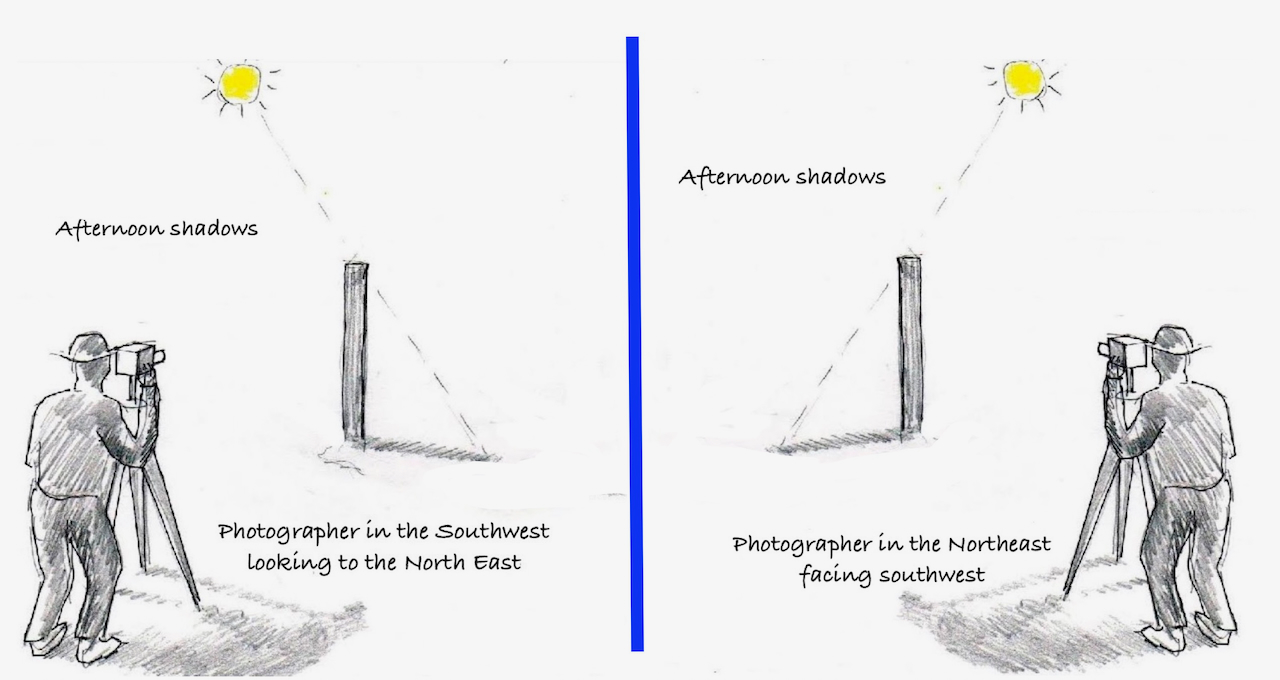
Now, as also illustrated in the diagrams, if you take a photo looking northeast towards the post, the shadow of the post will extend towards the right side of your image. On the other hand if you take a photo of the post from the north east looking to the southwest, then the shadow will extend towards the left of your image. These also are unarguable facts.
Now look at the shadow of the posts seen in the etching, which even Fitzsimons has said matches the photos: it very clearly and unequivocally extends to the LEFT which can only mean one thing: the photo was taken from the north east looking to the south, as Bill has been saying for years.
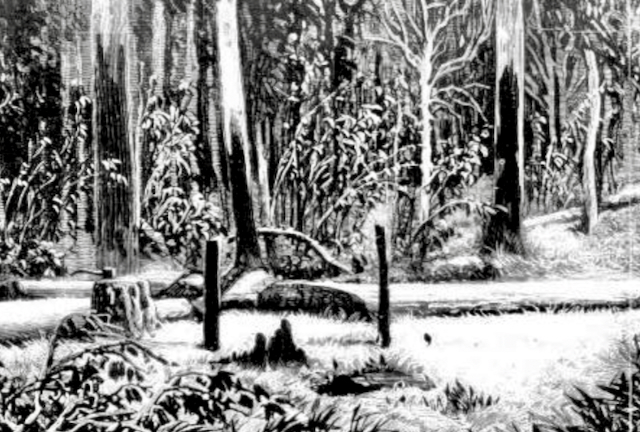
This shadow is also seen in Burman photo #2, but the artist has made it much more obvious in his etching. The artist, having been there and taken a note of direction and where the light was coming from has also enhanced all the other shadows in the image to make it clear that the sunlight is falling into the clearing from the right side of the frame. If this image and the etching were a view looking to the north east, the light would be entering from the left and shadows falling to the right…but they most definitely are NOT.
So what have we ended up with ? Well firstly we have actual quotations from McIntyre that confirm the images are of the police camp and of the actual ground where Lonigan and Scanlan were killed , and a valid conclusion based on an exhaustive search that he never said the photo was taken looking to the northeast. We also have confirmation provided by the artist who produced the etchings of where the light was coming from and where shadows are falling. As a result, we now have incontrovertible evidence of where the camera was positioned and thereby confirmation that Burman DID place his actors in correct orientation as to direction. There are many simple potential explanations for the fact that the actor that everyone agrees was playing “Kennedy” in the photos was not mounted on a horse, but none of them affect the validity of the argument about orientation.
Anyone claiming the opposite will now have to explain why the artist who made the etchings got it wrong, why McIntyre got it wrong when he said the Images showed the ground where Lonigan and Scanlan were killed, and why Burman got it wrong by deliberately putting his actors in all the wrong places, and have them all looking in the wrong direction.
For anyone who understands logic and reason, and is willing to follow the arguments to rational conclusions, the argument about orientation of the Burman photos is now over : they were taken from the north east looking to the south and southwest .
From here we can move on to discuss what is seen in them.
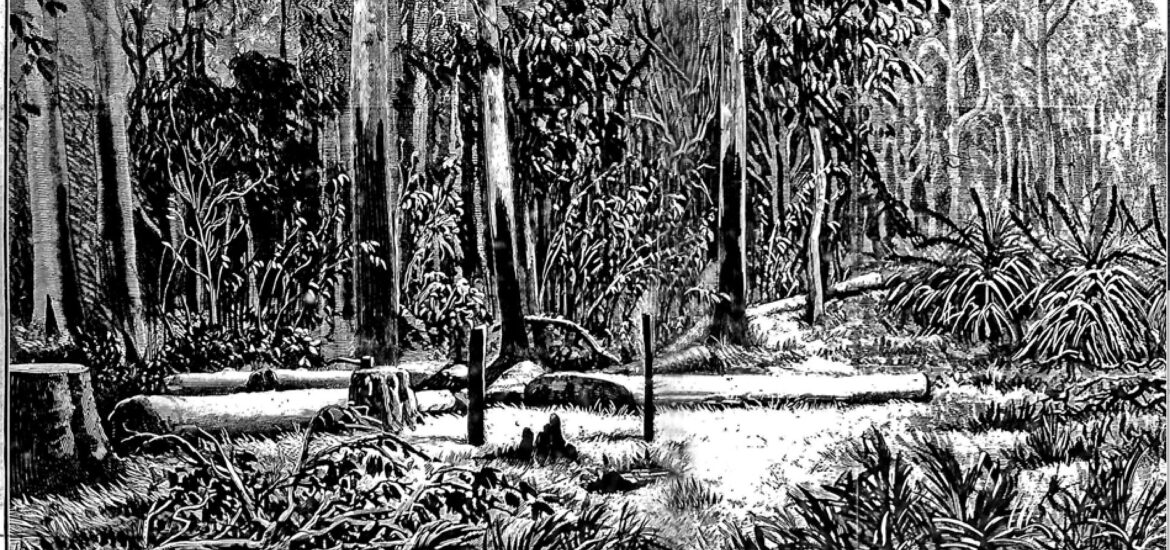
Hi David, thanks for the complment but out of fairness I’d like to say that in my opinion Sharon Hollingsworth does far and away the most rigorous fine tooth combing of the Kelly archives and newspaper documentation of the Kelly outbreak of anyone anywhere…
And I still haven’t re-searched the other four VPRS 4966 files (items 6, 7, 8 and 10) that have something by McIntyre just in case there might be a piece of accompanying police correspondence that was the holy grail of this search.
However, given that 4966 item 2 (the Murder file) is the place where all clues to date led, and there was nothing in that about McIntyre saying anything to anyone about the position of the Burman camera, I think it is (as you say) safe, unless proven otherwise, to work on the basis that no such comment was made by McIntyre, and that McMenomy 1984 and 2001 only inferred that conclusion from his reflections on McIntyre’s rough sketch map, as we all discussed in the previous blog devoted to this topic.
Is Keith McMenomy still around? Could he be asked to clarify? Anyone know?
Hi David you have done well with your interpretation of direction but I have some questions and I hope you can answer them.
Do we know for sure that the artist that did the sketch was with Burman or was he there later.?
What was the artists name?
Where did you get the idea that the photo was taken at noon or early arvo.?
Also I missed some of the comments about McIntyre stating where Burman took the photo, my opinion is he would never have stated that as he never seen Burman take the photo and never returned to that location for 24 years.
The camera position may of been a guess by him but he would not have done that.
Thanks Adrian, I’ll answer your questions as best I can.
Firstly you ask if the artist was with Burman. To be honest I haven’t checked but this is the claim made by Mick Fitzsimons that he was, Maybe ask him for his reference. I am blocked from his page but I dont think you are, so I suggest you go there and ask him then we will all know.
I dont know the artists name.
The claim about when the photo was taken is an assumption that all teams seem to have made.
I will look up these points over the next few days and let you know if I learn anything.
Hi David, as Jim has pointed out the timeline that we worked on meant the photo was taken mid morning. Burman was back in Mansfield by last light and it was a six hour ride.
The Burman photo appears to be overcast as the shadows are not that noticeable. I Burman had his back to the sun then the shadows would be harder to see.
Do you have Brian Carroll’s 1976 edition Ned Kelly Bushranger.
Bottom of page 76 to page 80 describes a unknown enterprising correspondent that traveled into SBC and Bullock creek with a guide.
I think it may have been Walter Lynch because he mentions Walters hut that was burnt and the fact that the guide knows where the Kelly’s camped.
He mentions doing a sketch as well.
Tell me what you think.
David you wrote in the above header:
“The CSI team, and Adam Fords team and Mick Fitzsimons and others, have always maintained McMenomys belief about orientation was the correct one, but clearly, none of them have ever actually seen the statement supposedly made by McIntyre, because if they had they wouldn’t have referenced McMenomy but McIntyre himself.”
The CSI team did not use McMenomy’s claim to establish the orientation of the photos. He just happened to agree with our conclusions. And if McIntyre did state the direction the photo was taken I’m sure Kelvyn would have found it and we would not be having this conversation. If you recall I questioned McIntyre’s supposed statement on your own Facebook site, Glenn.
From BBM Facebook page on SBC. Bills comments:
“He (McIntyre) drew his map with what he remembered and assumed the two logs in the Burman photo -(re camera position) was facing towards his two logs in front of their tent, and indicated the camera was looking towards the North East, But this was 100 degrees wrong, and Ned’s downfall because the magistrate believed McIntyre and not giving Ned a chance to explain from where the Kelly’s came into the police camp.”
“McIntyre got his orientation wrong when he suggested a photo (camera) was pointing N East. Ned wanted to use the Burman postcard No1 for orientation, to show from where they came into the camp from the south, this postcard evidence was rejected by the magistrate “as an unusual piece of evidence to produce” McIntyre’s story was believed and due to that, Ned was not able to claim self defence and was ultimately hanged. So, all you North East Burman photo believers, you are all hoodwinked by McIntyre and ignoring Neds case. This is the basis for my pending book on Ned’s self-defence case coming out soon.”
From your Blog:
“Hi Bill, I’ve been searching Mc’s various depositions in the posts above this one for him saying what you quoted, that “Both photos were taken from the direction of the bottom left-hand corner”, but haven’t found it yet. If you have an exact reference for the quote that would be great.”
Reply:
“Yes, ####, I saw the ref only the other day -it was as if it was common knowledge and I didn’t need to feature that, but I am sure it was in Mc’s deposition for Ned’s court case.”
Not Found.
Yes I agree there is no evidence that McIntyre said anything specific about what direction the camera was pointing in when the photos were taken. What he DID say is that they showed the ground where Lonigan and Scanlan were killed. He did NOT say of the images that this is the ground where the tent was and Lonigan was killed out of sight on the opposite side of those logs….
Contrary to what Fitzsimons is claiming on his utter disgrace of a FB page, Ive never said McIntyre got his orientation 180degrees out. That would only follow if he had stated the Camera was pointing to the north-east, but he never did. Fitzsimons is confused and hasnt understood what he has been reading.
So the CSI take comfort from the fact that McMenomy agrees with them : its an odd comfort to take when we now know that McMenomy didnt have a good reason for believing that!
So remind me if you would, was the CSI orientation claim based SOLELY on the burls seen in the Burman and the Beautiful Mansfield photos?
There was only 4 men in Burman’s party.
1. Burman
2. An unknown policeman, for protection
3. Monk
4. G.W. Hall, reporter & proprietor of the Mansfield Guardian.
Burman departed early from Monk’s sawmill for the 2hr journey to SBC, so arrived at SBC early morning. The photos were taken in the morning. The Police Camp photos are numbered 1 & 2. So these were taken before the Kennedy tree were photographed.
A storm with heavy rain hit in the afternoon. Burman must have left SBC after lunch as he is recorded as being back at Monk’s sawmill before late afternoon.
I believe any sketches done are referencing the Burman photos, & include some poetic license. We don’t know if the artist met & interviewed Burman but it is possible as this would have been how he viewed the photos to sketch. So I don’t think the shadows represent when the photos were taken exactly, But I do agree they generally depict the northern sky. The artist has the slope spot on too which is interesting.
Regards, Jim Fogarty
Thanks for that information Jim. Youre saying Fitzsimons was wrong to say that the artist accompanied Burman to the site…why am I not surprised?
Youve also said the photos were taken in the morning. Is that a calculation made by working out his travel times to and from the sawmill , and thereby establishing the time interval that Burman was actually at SBC…or from some other reference?
The sun must have been quite high in the sky, looking at the length of the post shadow in comparison with the post height, so if its morning, what time of the morning would you estimate?
In spite of what youve said I am still quite certain that the argument about shadows is still valid : its very clear from the way the shadows are drawn that sunlight is entering the scene from the right side of the clearing, which is the opposite side from which it ought to be appearing if the photo had been taken with the camera facing the northeast. Do you agree?
IN addition, the morning sun would have been in the northeastern sky, so if the camera was facing northeast as CSI and Fitzsimons claim, it would have been looking straight into the sun – not something I would have imagined a professional photographer would do – and shadows would be directed straight at the photographer, not to his left as shown.
The search parties would leave Monk’s at 5.30am for the 2 hour ride to SBC. The Burman party are reported as starting early from Monk’s. No time recorded. But early start it was. So that leaves the entire morning of sunlight open for photography. A storm was brewing. Rain came down in torrents in the afternoon. So Burman must have spent the morning taking his photos. Probably had some lunch, packed up and was back at Monk’s before early evening but we don’t know the exact time.
All I’m saying is there is nothing in reports that an artist was with Burman. They mention the Burman party consisted of 4.
I know it’s cumbersome to digest, but the timeline we did in our Addendum reports really helps to clarify lots of detail. Admittedly it would take a few days to read and read references, but for anyone interested in the topic it is well worth it and helps to clarify all the information and reports based on time stamps. Regards, Jim
Hi Jim, the idea that the (Australasian Sketcher) artist accompanied Burman came from McMenomy, whose ‘Authentic Illustrated History’ 2001 (2nd edn) p. 90 says, “An artist who accompanied the photographer described the spot where the constables camped…”.
You are however correct. The source McMenomy gave for that claim is the Australasian Sketcher November 1878. When we look at that paper, we find something different, and I have attached the page so everyone can read it for themselves.
What the Sketcher said is, ” Our artist, after his visit to the locality and the enquiries he made, handed us the follwoing explanatory notes…”.
There is nothing in the Sketcher that says the artist accompanied the Burman photographer. McMenomy made it up.
Attachment Australasian-Sketcher-23-11-1878-p-134.pdf
Hello Stuart,
I had never actually seen the written TEXTs for ‘The Australian Sketcher’ police camp etchings based on the Burman photos. It’s too obvious the scenes correspond exactly with the photos and to prepare the etching plates for printing would take days.
Of interest as well is drawing item 6, where Scanlan was found.
This view shows a person on a horse higher up the creek bank – this is consistent with the Two Huts site as there is still evidence of the bridle track passing this area where Scanlan was shot and the stump of the White Gum had stood that Jack Healy mentioned in his Women’s Day article in 1964.
Also this was right near where Trevor Scott metal detected a large cone bullet that fitted a Spencer rifle that Scanlan apparently fired just before he was killed.
Attachment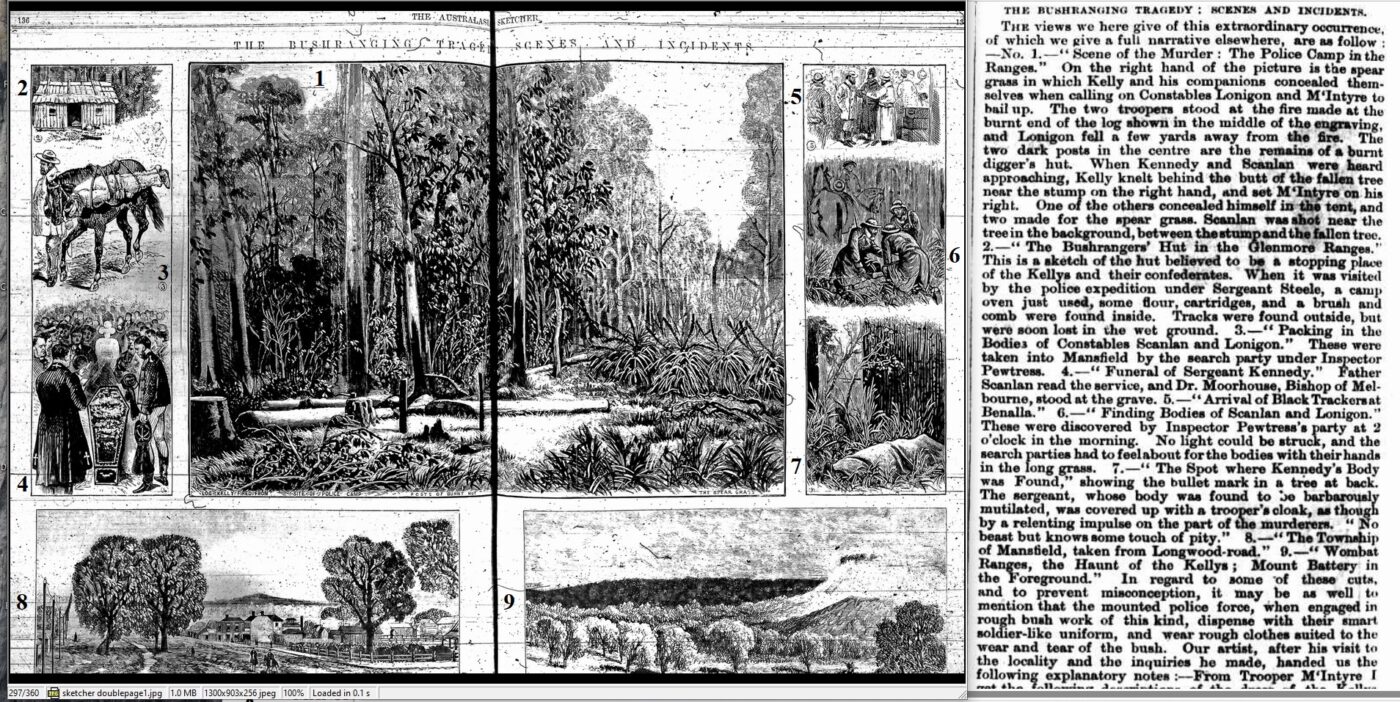
Hi Bil, you have the picures obviously; and I posted the text of p. 134. Here is page 135 attached. The blog will only let me post 1 document at a time, so I’ll put p. 138, the last text page, up next.
Attachment Australasian-Sketcher-23-11-1878-p-135.pdf
Hi Bill, here is page 138
Attachment Australasian-Sketcher-23-11-1878-p-138.pdf
BILL REPLY
19/10/2017 at 3:02 am
PS: And one other thing about that bullet.
Last year around the time I was in contact with Genepool about the pending documentary, I spoke to Terry Scott the Spencer bullet finder by phone and was quite taken aback when he told me he had NOT actually found the bullet where he said and showed me. He said he was mistaken because it was his brother in-law that had found it, but further UP the creek. I said that changes everything does it not? Yes he said, sorry.
During Oct 2003, the official installation at SBC of the Police Memorial stone, I ran into Bob Bretherton of nearby Tolmie. Bob was an active member of a local historical firearms- Re Enactment Group. Bob told me he and his gang had often gone to SBC for the purpose of firing off of antique firearms. He had quite a collection apparently. He told me some would get all dressed up in police and civilian clothing of the times and apparently had a whale of a time.
I am beginning to think since Terry changed his bullet story to me, perhaps the bullet he detected was not found early 1980s looking for gold, rather more recently after he had read my two huts webpage and about those gold workings near the two huts fireplaces. Was the bullet he detected discharged from one of Bob Brethertons re enactments. Who knows how many false musket balls and or antique shell cases may be laying around SBC picnic ground area. What may come next boggles the mind
Yes, Anon, That’s what I wrote somewhere years ago, probably to the CSI @ SBC people after they had been contacted by Terry Scott saying he might have got his bullet-finding location wrong.
The funny thing was that Terry had no doubt about the area where he found the bullet in late 1978 or early 1980.
Attachment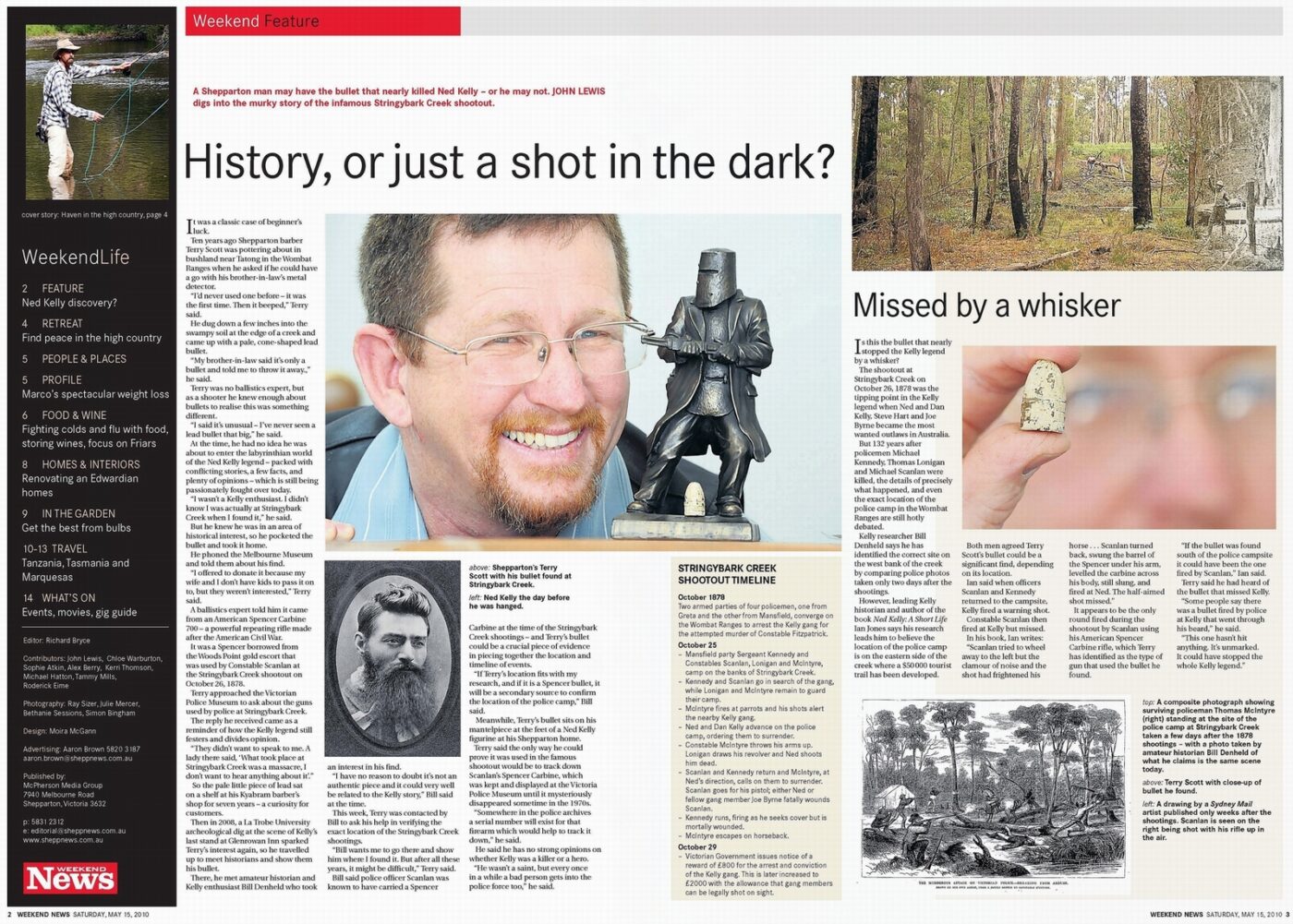
Stuart, very kind of you to say such nice things about my research abilities, but there are some parts of the Kelly story that I don’t bother with much, SBC being one of them. Your research and writing abilities are not too shabby, either! Looking at trove I see that when Mr Burman was going to SBC there was a reporter (supposedly Hall who was mentioned in earlier comment) who went along, too. There had been a newspaper artist who wound up leaving Mansfield when he realised that there would be photographs taken according to the reporter. Would an artist have gone with another party? https://trove.nla.gov.au/newspaper/article/246220116
Hi Sharon, that’s a great article you linked there, and it fits in with the Australasian Sketcher page I just posted in reply to Anonymous (Jim) which shows that the Sketcher artist did not claim to have accompanied Burman. Now your article states clearly that he didn’t.
Your Trove article has a lot of detail about the orientation of people in the SBC confrontation which others will no doubt enjoy, but my favorite line is at the start: “Every drunken loafer who is in his cups and talks wildly is at once put down as a friend of the Kellys on the look-out for information.”
Nothing’s changed, LOL.
Interesting read Sharon. After taking notes at SBC the special reporter (G. W. Hall) took his leave to meet up with a police patrol, leaving Mr Burman to photograph the various scenes.
Unless Burman included himself in the photographs there had to have been more than 4 in Burman’s party.
Thank you, Sharon, for linking us to a most relevant historical records via TROVE.
I doubt that the artist from the Aus Sketcher would go along. It’s even surprising that a photographer would go with all his gear if there was a chance of bad weather. The flooded Broken River* crossing would be bad enough considering his camera and glass photo plates were never to get soaked or rained on.
In the text, I cannot identify the Broken River, – I think it should have been ‘Bridge Creek’ as the Broken River is way up north, and an arm of it runs to north of the ranges whereas the photo party came from the south up into the ranges through Mount Battery Run and there they had to cross Bridge Creek which in that time may not have had a bridge?
Attachment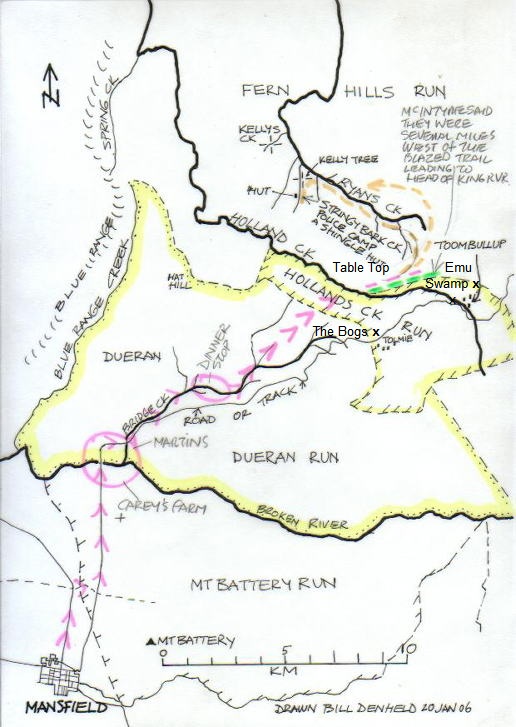
While I have marked Broken River on my map drawing defining the boundary between Mt Battery and Dueran Run. By careful examination of other maps, it is the Broken River they had to cross as Bridge Creek flows into it, so, sorry to cause confusion. I added the map to give readers an idea of the trip the original police party had taken. The green dotted line was a tree-blazed trail that defined Ewen Tolmie’s Holland’s Creek lease, this line pointed to the headwaters of the King River where James Quinn had Glenmore station Run.
Ok, the way I am reading the article is that Burman engaged a local to guide them and when they were getting ready to leave that morning Monk came into town and offered his services and Hall says that four of them set out (which would be the original guide, Burman, Monk, and Hall). The article goes on to say four came back into Mansfield (says Hall, Burman, the guide and a trooper) so they might have dropped off Monk at his place and the local guide brought them back into town. The trooper might have been one on patrol that Hall says was met up with? Maybe a constable did not accompany them from the outset? Was the trooper at the scene to be photographed? Or did Burman do a selfie? Or was Hall in some of the pics but not all? Too bad we don’t have photos of what all the players looked like to compare.
Hi Sharon, I agree with that. That article starts of with a party of 4 going from Mansfield: Hall, who is presumably the author of this article; a guide from Mansfield; Monk; and Burman. When they cross a surging river in the ROUTE section, the same four only are listed.
Once they get to SBC, Hall goes off to meet a police patrol he beleives is in the area. What we don’t know is whether he participated in being photographed before the point when he left, as he says only “I found a number of the feathers of the parrot which M‘Intyre shot in the morning before the Kellys came upon him. Taking some of these and the blood-stained gum leaves as souvenirs of my visit, and leaving Mr Burman to photograph the various scenes, I struck across country to pick up a POLICE PATROL. which I understood was to pass”.
Was there any equivalent of a time delay in those cameras? Bill might know. Could Hall have been one of the men in the two Burman photos we know of, before he left? Could one of the men in the photos have been superimposed during printing, e.g. the right hand man?
After Hall left the police patrol, “I bade the patrol good evening, and pushed on to Monk’s place, which I reached safely shortly after Mr Burman and his guides had arrived. . During our ride we saw almost all the Victorian fauna.” It is not super clear from this whether Hall was accompanied back to Monk’s from the police patrol by one policeman, but it seems possible.. The article then goes on to say that after leaving Monk’s, “The photographer, the guide, a constable and myself reached Mansfield in safety,”
What is clear is that at no point was the party accompanied by a sketch artist.
Hello Stuart,
You wondered if cameras in those days had a time delay function allowed the photographer to set the camera and jump into the scene. My camera book says a time delay did not come in till about 1912.
Thanks Bill!
Hall is the short stout man on the right in the Kennedy tree pic. He can be seen in the PC photo too. I have found a portrait photo of Hall and he wears the exact same tie. Monk is under the blanket. Man at left is a policeman (in Kennedy tree pic). This was only a week after the shootings. A guide in this instance refers to a policeman from my understanding, as Monk was referred to as a guide during the first search for Lonigan & Scanlan. I don’t think anyone would have been allowed to travel in the area without a police guide immediately after the shootings. I don’t think anyone probably wanted to travel without a police guide. It sounds like there were many police patrols at this stage. After taking the photos, Burman with Monk and the policeman rode 2hrs back to Monk’s sawmill. Hall arrived after them at Monk’s by early evening after being with another police patrol for lunch. They stayed at Monk’s that night then rode the 4hr journey back to Mansfield the next day.
Two interesting points is that with all the police in the area, would Burman have got the details of the photo so wrong?
And, knowing a storm was brewing and rain fell in torrents that afternoon, remember those sapling trees bending to the right in the PC photo I’ve mentioned previously? I’ll leave it to you to ascertain from which direction wind squalls proceeding a rainstorm would be coming from. I believe this is an important clue as to orientation of the Burman PC photos.
Regards, Jim Fogarty
Article says – “This
knight of the camera, after some hunting
about and invoking the aid of one of the
principal residents of the district, found a
man who knew the country and who was
willing to supply horses and run the risk of
a bullet for a given sum. This man was en-
gaged. ”
So, that was the “guide” whether or not he was in the police is debatable. But on the way back after presumably dropping off Monk at his home, it says the guide, Burman, trooper, and Hall came back into Mansfield. So, at least Hall was in some of the pics given the proven image of him later. With no artist in sight or on site! We are making some progress here!
Hi Sharon and Jim, what the Sketcher Nov 1978 said is, ” Our artist, after his visit to the locality and the enquiries he made, handed us the following explanatory notes…”.
Wehave been able to establish that the Sketcher artist did not accompany the Burman trip to SBC. That was 4 men only. The suggestion that one of these could have been a policemen is problematic as Hall’s write-up in the Herald said that he “after some hunting about and invoking the aid of one of the principal residents of the district found a man who knew the country and who was willing to supply horses and run the risk of a bullet for a given sum.” That doesn’t sound like it was a policeman, as the guide was a hired man who could supply horses. Had it been a policeman, horses would have to be signed out from a police station, where in a further difficulty there were unlikely to be any spare horses for a photogrpaher’s trip given the demand on them for police patrols. The third issue is that Hall hd no problem writing that a trooper accompanied them back to Mansfield from Monk’s; or writing up his encounter and overnight stay with a poklice patrol; so it is hard to see why he would not mention that his Mansfield guide for the trip out was a policeman if it had been one.
The other issue is the Sketcher saying that its artist visited “the locality”. Does this mean Mansfield as the locality, where we know from the Herald that the artist was, or does it mean that the artist at a later different time visited the locality of the murders, i.e. SBC? As the Herald alos said of the artist that “as a photograph of the scene would suit him equally well, the military-looking artist left Mansfield”. I’m inclined to think that “the locality” means Mansfield rather than SBC; and to suggest that the artist may have made an arrangement with Burman to supply him with a photograph of the ground at SBC when he got back to Melbourne. In support of this possibility, there are no human figures in the Sketcher’s illustration. It is a sketch of the site with a text description of what happened there.
To be clear, I have only been looking at the question of whether or not the Skjetcher artist accompanied Burman’s photo-shoot; and it seems clear that he did not, as the Herald has Hall stating that the artist left Mansfield before his photo expedition headed out.
Assuming Hall is the author, does anyone know if the Herald article alaso appearred in another paper, e.g. the O&M or a Mansfield paper? There is a significant chunk of text missing from the bottom of the Herald page in Trove due to page damage; perhaps if the article ran elsewhere, we could find the missing text?
It would be interesting to delve deeper into McIntyre’s maps of the police camp. The first one is very basic and possibly sketched when McIntyre first arrived back in Mansfield after the shootings. He was rushed and obviously exhausted etc. He left on the 1st search party within hours, so a basic sketch is understandable. No tent on 1st sketch from my memory.
The 2nd sketch is more detailed. There are different coloured inks used for the text. Did the ink run out or was it drawn over different stages and added to for the pending court hearing? It would be interesting to cross reference McIntyre’s handwriting to confirm he wrote the text. Did McIntyre even sketch the 2nd map or was it a lawyer that referenced McIntyre’s first sketch? When was it drawn exactly? Was the tent and north arrow on original sketch or added by another person? And if McIntyre got something wrong in his first owing to not being clear headed, did this impact what was drawn in the 2nd sketch? Changing the 2nd sketch to correct an inaccuracy might not have been a good look for the case. So much importance on the police camp layout is placed on the 2nd sketch but how reliable is it actually?
Having multiple people good at research targeting detailed topics is very productive. I’m not aware of any deep analysis having been done on the maps. Could be very interesting. Regards, Jim
Bill, I am surprised that no one else had ever run across this article or mentioned it. It is a good one and very descriptive. I suppose that up until recently The Herald (and The Age) were not as readily available to access and read online as The Argus. Too bad parts are damaged and cannot be read. Stuart, I tried searching Trove for another paper with some of the same terms/phrases and nothing came up except the Herald article itself, but all papers are not there. Regarding the drawing of the maps, the different inks and comparing writing, that is not something in my wheelhouse. Maybe someone else can figure all that out. I wonder how Hall allegedly became the special reporter for The Herald? Was it because he was based in the area and had the writing expertise?
Hi Sharon, my wild guess was that he wrote the article for his own paper and sold it on through a wire service; hence trying to think of another paper that might have run it; or perhaps the Herald paid him for copy knowing that he was going with Burman; or maybe something else. I guess we’ll never know 🤷
Stuart, reading the article it sounds like he did not know Burman was coming, that Burman just showed up in a wild coincidence. Otherwise, the artist would have not bothered trying to go to start with? As I always say, we need a time machine! This has been a fun comment thread, we learn stuff, we use critical thinking and research skills. We have different people with different agendas or no agendas just coming together with no acrimony to try to figure things out. THIS is how it should be done without all the ridiculous/childish/foolish/dangerous behavior exhibited by supposedly grown men elsewhere.
Hi Sharon, yes, it’s fun pursuing ideas without an agenda. I think of it as throwing all the evidence up in the air and seeing what documented facts fall out. Sometimes they don’t fit any theory at all, probably because back in the day there was no inevitability about anything and what we have is just partial records of things that happened. Maybe that’s why one of the ancient historians (can’t remember who, maybe Xenophon?) said that the hardest history to write is the history of one’s own times. Always disputed hotly as it happens; but Herodotus and Thucydides both show how recording what happened including disputes about interpretation was all part of writing history.
Here is the link the portrait photo of G.W Hall I found online. Look closely at his necktie and then compare to the short stout man on the right of the Burman Kennedy photo. The same man is sitting on the log in the police camp photo. If it is not him then I am wrong but see what you think?
https://www.upperbeaconsfieldhistory.org.au/g0/p201.htm
Attachment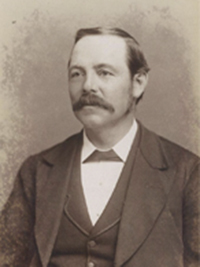
Hi Jim, if you’re asking me (Stuart), I avoid anything to do with photographic interpretation. Remember how Ian Jones misidentified a photo of some guy as Gentleman Ned for years and someone who bought it at auction on that basis was refunded his $15K when it was proved wrong? And the controversy over the alleged Woodcutter Ned photo from the Kelly Vault which is most likely not Ned (and even the expert gave it only a possible ID, not a high certainty)?
What about the Boxing Ned photo which is clearly staged before an event, not a post-barenuckle fight champion photo?
I stay away from all such things as speculative and leave them to others!
I AM POSTING THIS FOR BILL WHO FOR SOME REASON COULDNT UPLOAD TO THE NLOG TODAY:
Without a shadow of a doubt, some belated replies from me.For the most part, this discussion has centered around the party of four that went to photograph the SBC site.
Jim asks whether McIntyre’s detailed map has had any serious scrutiny, as to whether it was part of McIntyre’s ‘Deposition case against Kelly’,and what is the history of McIntyre’s map.
My thoughts are:McIntyre had produced his manuscript some 24 years after the SBC event, basically, he wrote this on page 2
“ Having family it has long been my desire to leave on record for their information, for nothing else, an account of my experience with the Kelly gang of Bushrangers”..
This would have been in 1902, and in November 1988, his document came to light when McIntyre’s granddaughter Mrs Hockey donated it to the Victorian Police Historical Unit. But it was 21 years later that VPHU curator Lis Marsden came across McIntyre’s detailed map, so this map may have been part of that donation.It was in 2009, from this Mc map that I saw at the VPHU display that I photographed his map, and is the one most people online are referring to.
From it I was able to reconstruct a more understandable map using every detail from all sources for the purpose of the group of five that Gary Dean and I had put together for a SBC Symposium to be held following our findings.This never happened because of differences of opinion, and I was asked to leave the group. However, to date no other group has ever been able to put together anything that matches this attached layout.
https://www.ironicon.com.au/images/mcintyres-map-at-sbc-2-huts.jpg
https://ironicon.com.au/images/mcintyres-map-at-sbc-2-huts.jpg
If this fails click on above link
Attachment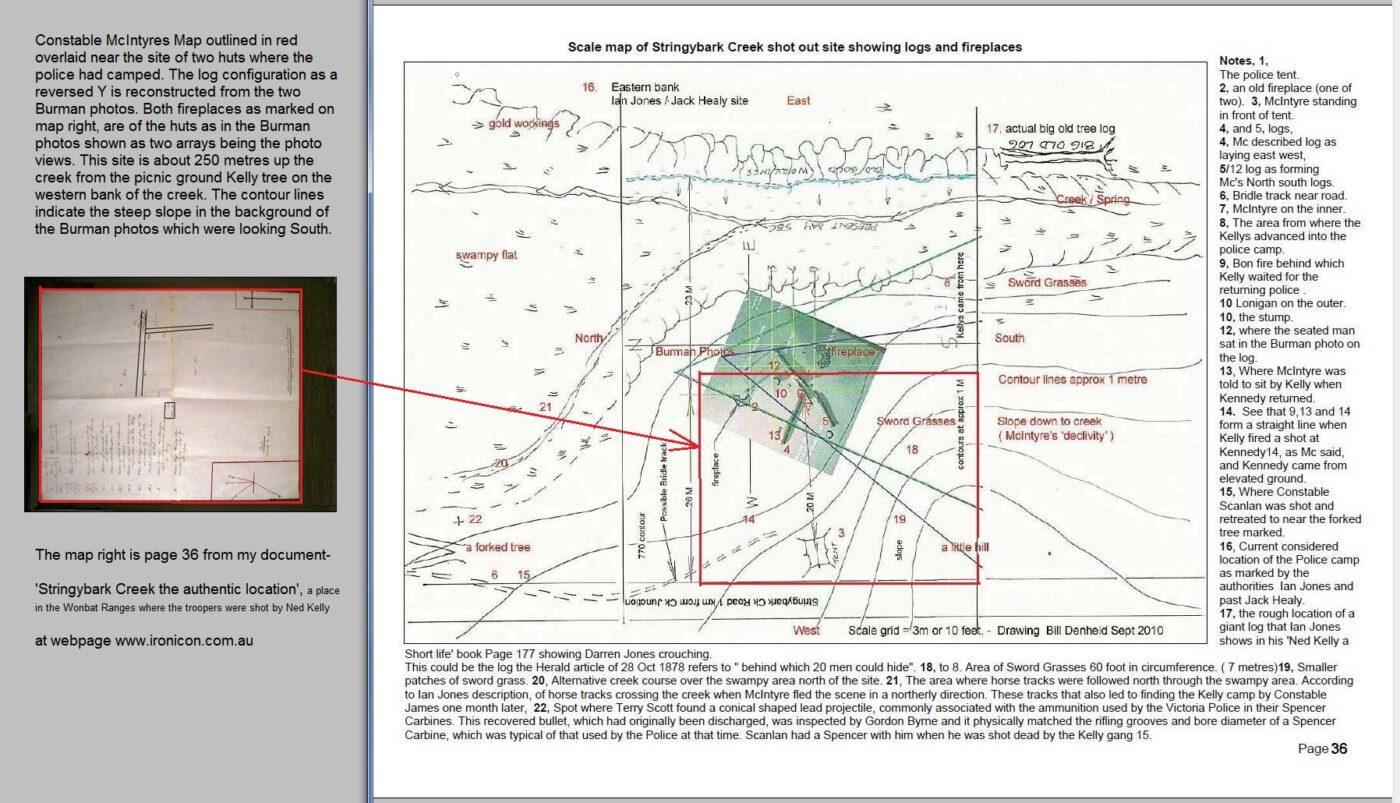
Hi Bill, from what I can make of Liz Marsden’s comment in her chapter on McIntyre in Craig Cormick’s Under the Microscope, the donated documents comprised his typescript memoir, 3 scrapbooks of newspaper clippings and his detailed map. So there is nothing to indicate when he made that map, whether soon after the events or later. The map is not something referred to in his ~1902 memoir, of which there is a handwritten version in the SLV that I haven’t seen, but it logically predates his typescript. He began the scrapbooks early. The map may well be early too. Perhaps he drew it as an aide memoir but not as something needing to be produced in court? But we are into guesswork now…
Hello Stuart, I agree, but if Mc’s map had been in existence in 1880s, historians like JJ Kenneally, McQuilton Jones and McMenomy would have used it in their publications. However it is in Ian MacFarlane’s 2012 Un Masked book, so this lines up with Lis Marsden’s uncovering the map after Mr and Mrs Hookey’s donation of Mc’s scrapbook collections.
Yes Bill, Liz Marsden refers in the Cormick book to getting some McIntyre stuff in 2009 so that sounds likely. I guess the only way to find out (if it matters) would be to email the VPM and ask if they have any info about the map and its history.
Stuart, there was this from the Sydney Morning Herald of Sept 12, 2011– “….McIntyre’s story re-emerged in 2008 when his scrapbooks were being documented and filed. The map was later discovered in these scrapbooks, but even then its significance was not apparent. Historians realised its worth when it went on display at an annual festival in Beechworth in 2009.”
Hi Sharon, the Vic Police Museum have 3 McIntyre scrapbooks. One is for 1878, another is for 1879, and the third is for 1800-1881. They all consist entirely of newspaper clippings about SBC and the Kelly gang.
As the map was discovered in one of the scrapbooks, that may suggest a creation date in that period, rather than at some later point, e.g. when he was writing his memoir many years later.
My hunch is that he may have drawn it for himself as a memory aide at some point before the main trial. It would be interesting to know which scrapbook it was found in.
Sharon linked us to this relevant historical account on TROVE on 22/09/2023
https://trove.nla.gov.au/newspaper/article/246220116
In this TROVE page there are some key points that all SBC contenders need to take notice of since we are not only discussing orientation of the Burman photos, but also the actual location.
As typed on the TROVE page-
” The police tent was pitched on the northern slope of the hill. ” – and –
“At the rear of the tent, the slope goes gradually up to the summit.”
My comment:
There is only one little hill slope along the western bank of SBC that fits these above descriptions,- and only at the two huts fireplaces.
There are other written descriptions of the way the tent opening faced. McIntyre said East towards the creek. So we know we are on the west bank of the creek.
Click on the map posted above. This area is 300 m up SBC road from the Kelly tree.
Image Trove- The Mansfield Tragedy – little hill
Attachment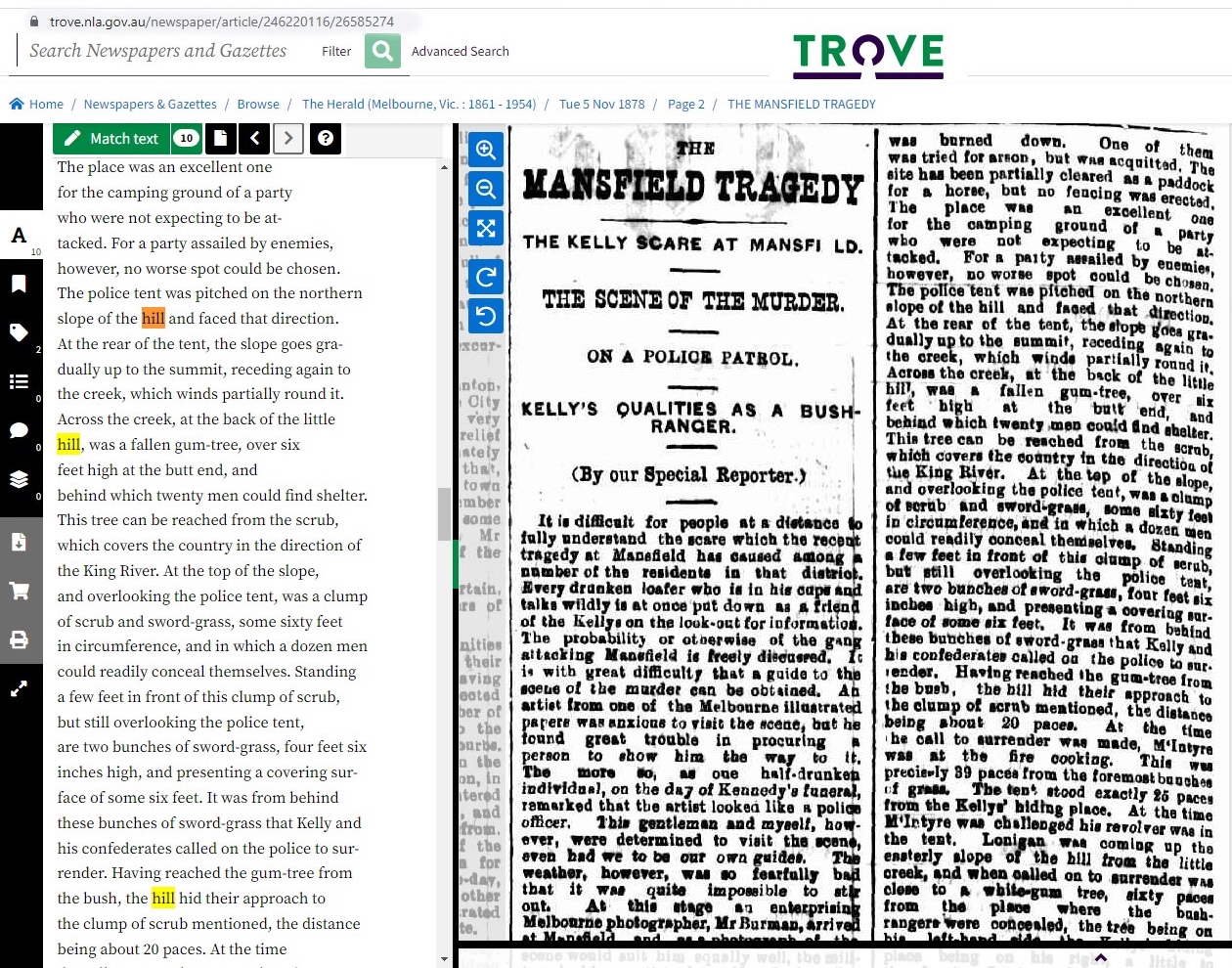
Sharon linked us to this relevant historical account on TROVE on 22/09/2023
https://trove.nla.gov.au/newspaper/article/246220116
In this TROVE page there are some key points that all SBC contenders need to take notice of since we are not only discussing orientation of the Burman photos, but also the actual location.
As typed on the TROVE page-
“The police tent was pitched on the northern slope of the hill.” –
“At the rear of the tent, the slope goes gradually up to the summit.”
Comment:
There is only one little hill slope along the western bank of SBC that fits these above descriptions,- near the two huts.
There are other written descriptions about the way the police tent ‘opening’ faced. McIntyre said East towards the creek. So we know we are on the west bank of the creek.
Sharon linked us to this relevant historical account on TROVE on 22/09/2023
https://trove.nla.gov.au/newspaper/article/246220116
In this TROVE page there are some key points that all SBC contenders need to take notice of since we are not only discussing orientation of the Burman photos, but also the actual location.
As typed on the TROVE page-
“The police tent was pitched on the northern slope of the hill.” –
“At the rear of the tent, the slope goes gradually up to the summit.”
Comment:
There is only one little hill slope along the western bank of SBC that fits these above descriptions,- near the two huts.
There are other written descriptions about the way the tent opening faced. McIntyre said East towards the creek. So we know we are on the west bank of the creek.
This image will give you an idea of 4 views
https://ironicon.com.au/images/SBC-1234.jpg
Attachment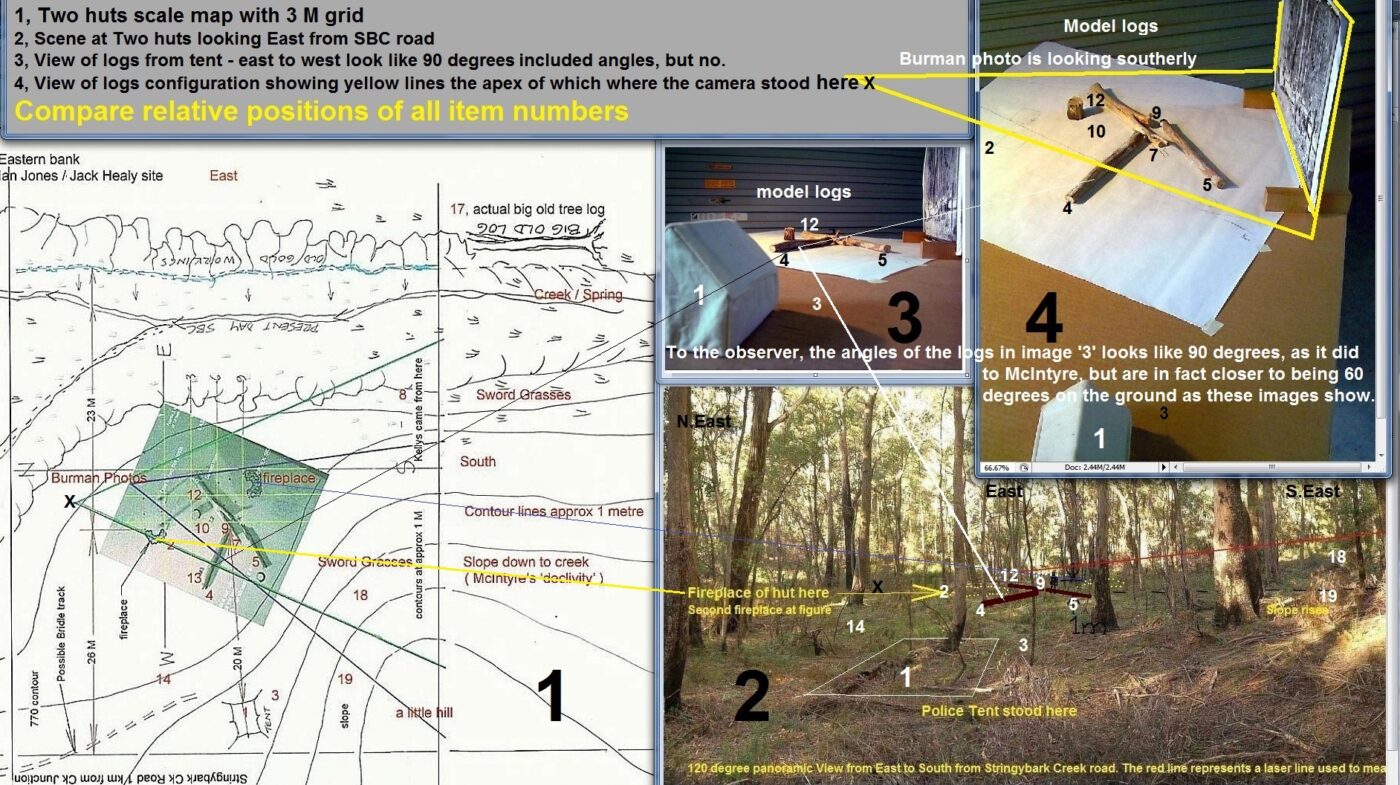
My previous post has not shown ????
Sharon linked us to this relevant historical account on TROVE on 22/09/2023
https://trove.nla.gov.au/newspaper/article/246220116
In this TROVE page there are some key points that all SBC contenders need to take notice of since we are not only discussing the orientation of the Burman photos but also the actual location.
As typed on the TROVE page-
“The police tent was pitched on the northern slope of the hill.” –
“At the rear of the tent, the slope goes gradually up to the summit.”
Comment:
There is only one little hill slope along the western bank of SBC that fits these above descriptions,- near the two huts.
In the written description about the way the tent opening faced varies from McIntyre who said East towards the creek. So we know we are on the west bank of the creek.
Bill, I guess you will need to update your book to include this newly found report, good thing you are still in the pre-publication phase.
Yes Sharon,
It’s a bit hard to believe that historical records described in primary sources are not considered by others.
The mention of a “little hill”, ” the northern side of the slope”, “at the back of the little hill”, and ” at the top of the slope and overlooking the police tent” -these clues have been ignored not only by the authorities, but by every other SBC site contender group since I first published my SBC Investigation webpage in 2009, and 2011 at –
https://ironicon.com.au/stringybarkckinvestigation.htm
and https://ironicon.com.au/stringybark_ck_the_authentic_location.pdf
Each of the above references to ‘the little hill and slope’ form the single most basic requirement to allow proper identification of the true site. How can anyone seriously debating locations, ignore such key features?
Yes Sharon, thanks to you, you have brought to the surface a document that has been largely ignored by the other contenders because it does not fit with their beliefs or scenarios, and I will make sure the ‘little hill’ becomes an important observation in my pending book publication, which is in support of Ned and historical truth. With thanks, Bill
Bill that report also says there were no fences, but the Kennedy Tree Group claim they can see fences in the Burman photos….fences which nobody else claimed to be able to see and which the eye witness didnt see either….
Jim Fogarty also suggested the saplings seen on the slope were leaning over because of a strong wind : I find it hard to believe that if there was a wind strong enough to blow those saplings right over, branches and thin tree trunks would be moving all about and result in blurred images of those structures but they are sharp and clear. Are there other possible explanations for saplings being bent over like that?
Hello David, Jim’s observation of bent saplings is a good one, but I think the reason they are bent is that a sapling in amongst tall tree canopies will reach for the sky. When the first occupants of the two huts and later prospectors cleared all large trees, this left the immediate surrounding forest exposed to strong winds pushing the saplings over while still trying to shoot up. As a consequence of wind and storms from the north, this would bend them over until they fell over.
So, in conclusion, I would say that together with the swampy ground immediately to the north of the two huts site – also being clear of all tall trees, and the fact the previous occupants had cleared “an acre or two” to the east of SBC – leaving the more natural bush to the south and west (of the two huts) intact, this left saplings constantly exposed to strong winds bending them over as they tried to grow up and over even without any wind.
Interestingly, on the slope in Burman photo No1, there are numerous saplings all laying along one direction. When I first visited the slope in 2002, I can remember seeing lots of thin saplings lying in one direction.
Bill, I had kinda wondered if others might have previously seen the article during their searches and just ignored it and pretended it did not exist since it did not fit their agenda. Then, along I come and accidentally stumble over it in pursuit of other knowledge just in the nick of time for your book. Gotta love a wonderful coincidence like that. 😉
Hello Sharon,
I had wondered that myself. I think they call it cherry picking, only pick the ones you like the look of and ignore the rest. As your link to the TROVE page (image above) points out about the ‘Little Hill and Slope’ where the police had camped, it’s a wonder that our generation of investigators are still hammering their belief as an ‘agenda’ to be right, when all along they should have listened to their Guru Mr Ian Jones.
In an article by journalist John Lahey – “Ned Kelly Revisited” in The Age 10 Oct 1995, he quotes Ian Jones standing there looking west from his east bank site to the slope on the west bank and – Lahey writes –
” Looking west from the east bank, you see a hillside uncannily like the one in the old photos from the time. And then there’s the swamp. Constable McIntyre, the only policeman to escape the Kellys’ bullets, galloped off across a swamp immediately to the north.”
See Appendix 1 at- https://ironicon.com.au/stringybarkckinvestigation.htm
So here is Jones telling his audience -look over there -see that hillside over there, it’s just “like the one in the old photos from the time”. This was well before people had internet and forums, yet when I tried to tell Jones of finding the two huts fireplaces, he knew that was where the slope was. How come he then ignored these findings? Because he had a book to sell.
Here was the start of his narcissistic stance where his beliefs overrode historical truth.
I just ask all SBC site contenders ( and there are dozens) to put up their case or accept the historical truth.
Surely, if they don’t have a “little hill or a slope” from which you could look down onto a police tent, “with a swamp to the north” then they must be on another planet.
This image has most Stringy Bark Creek site contenders in a hole. It highlights the little hill (circled) that Ian Jones could see from his preferred East bank site in 1993.
On the map the apex of the ‘V arrays’ represents where some believe the Burman photo was taken, – see the four Xs on the map where the contour lines are far apart.
The CSI team ‘X’ still seems to support their site as do half a dozen other highly vocal opinionated experts on Facebook pages, but I wonder how they can justify their belief if there is no little hill there, just like the picnic ground that Adam Ford in his Outlawed NK doco made out to be the site.
Then we should ask the KTR group the same question, even though they reckon the site is way down the road out of view from this map – where the landscape is flattish ground with no little hill in sight. While I estimated the height of the slope in the photo to be 5 metres high to the base of those trees, this was due to the number of contour lines on the map, but the next time I am up there I will do a laser height measurement from where the logs may have layn, and I estimate the little hill could be up to 3 m higher. (8 to 10 metres)
Attachment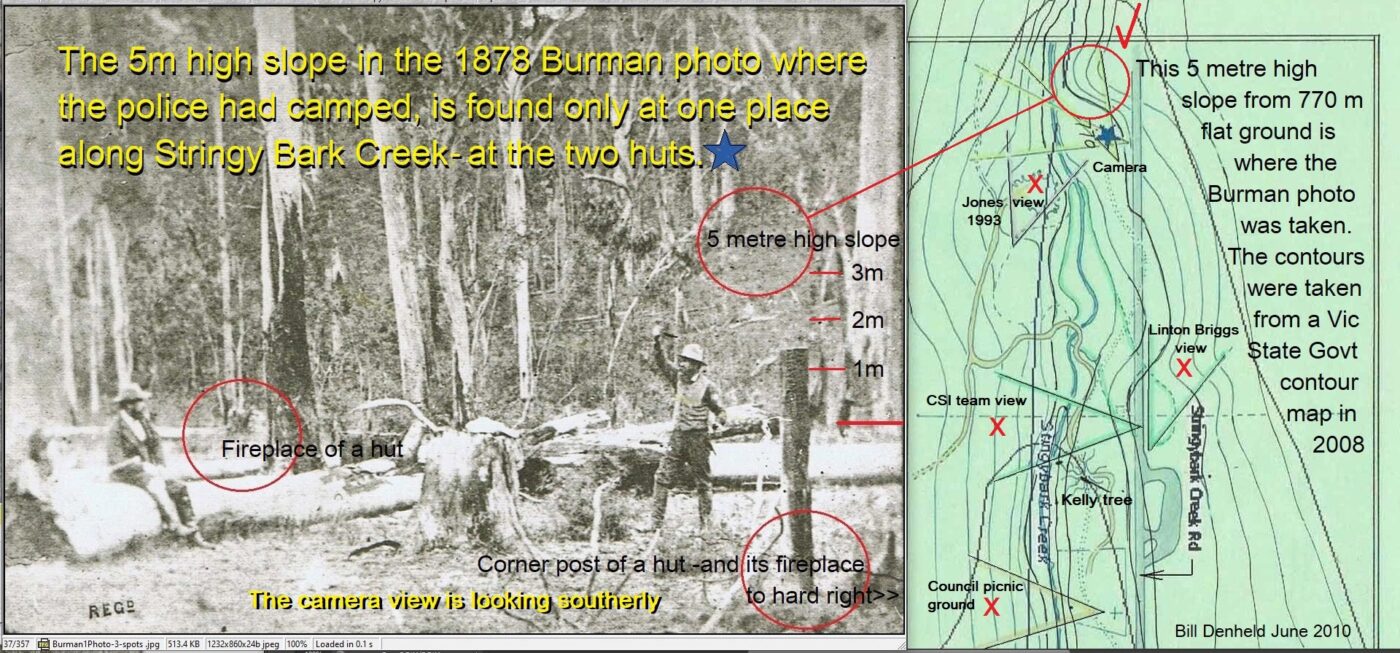
Hi Bill,
You obviously have not even looked at the site we have reported on.
If you had you would not that it is on the forward northern slope and the area to the north is a wet area right next to the little round hill where Kennedy and Scanlon came from. As for that trove article, we were never engorging it as it fits our location.
Sharon may have just found it, but so can anyone as we did years ago. Not anything new as far as we are concerned.
There is no little round hill at the pill of rocks site, it a bank of the creek that rises back up to the south.
By the way where is your steep slope that you think is in the photo, the sketcher didn’t seem to draw it.
Hello Adrian, why not show us all here a photo of your hill slope compared to the Burman photo No1.
The Sketcher artist only wanted to draw the are of spear grasses where two of the Kellys hid while waiting for Kennedy and Scanlan. If he had drawn trees up the slope the viewer would not know what they were looking at.
With regard to your site, it is gentle undulating ground heading down the creek north, but there is no slope that a newspaper reporter could stand on and say-
” “The police tent was pitched on the northern slope of the hill.” and ” at the top of the slope and overlooking the police tent.”
Show us a contour map or a photo of your hill slope.
Adrian, does this image help to explain the Australian Sketcher artist needs to exclude the slope, as you can see in this image where the slope would be.
Attachment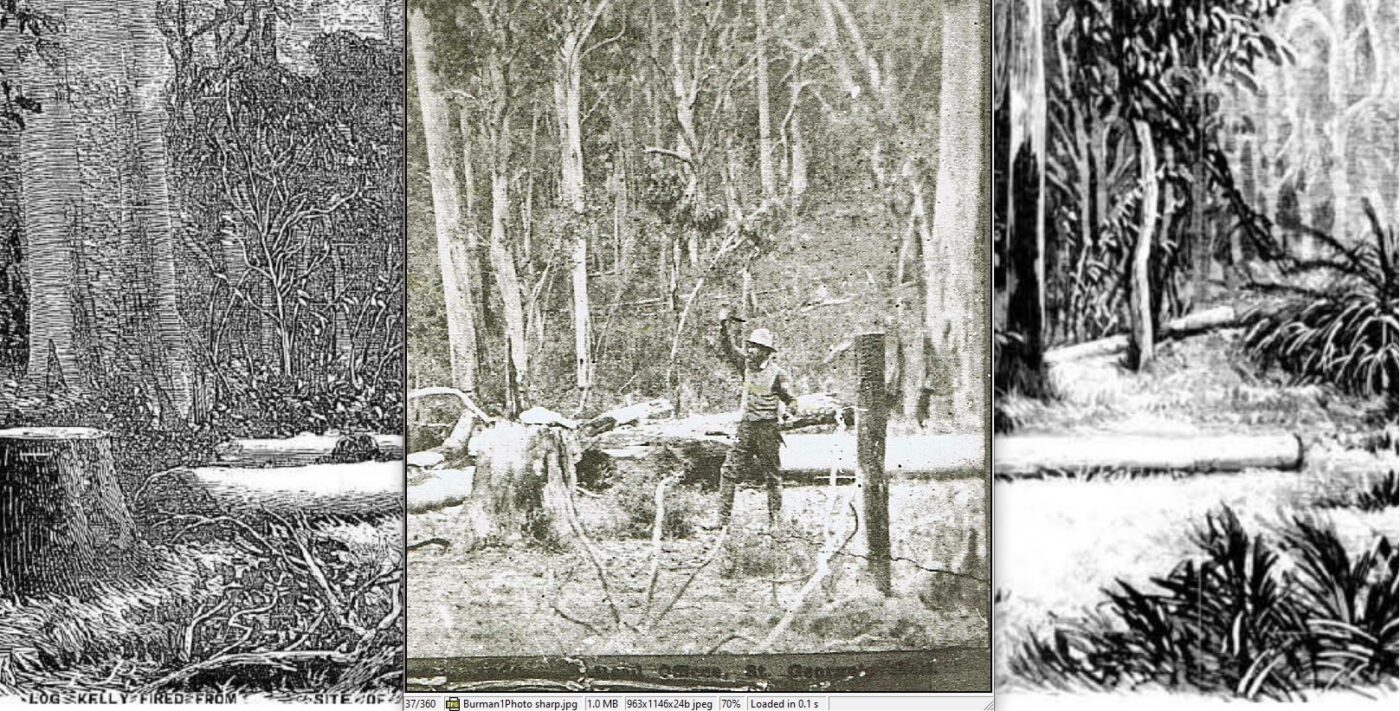
Well Bill I could but you just answered it for me in your own words,
(It is gentle undulating ground heading down the creek north)
Is that not a northern slope if it’s heading DOWN and NORTH.
The little round hill is at the end of this slope where the creek winds around it in the direction of the King river.
Heading back up the slope to the south there is a location that gives good observation over the police camp were the Kelly’s could see and not give themselves away.
I don’t believe the Kelly’s were observing the camp up close or they would be compromised, so it must have been some distance.
This is something I have lots of experience doing.
You can ask any soldier that’s been on operations and they will tell you the same thing.
Be in a good place the see and not be seen
Is this the photo you were looking for? Interesting to compare it with the artists hill. Matches uncannily well wouldn’t you say?
FYI the pic is from our Facebook page we posted it ages ago so it’s nothing new. For some reason some people keep saying we don’t have a slope at our site…yet we always have and have always said we have. Jim
Attachment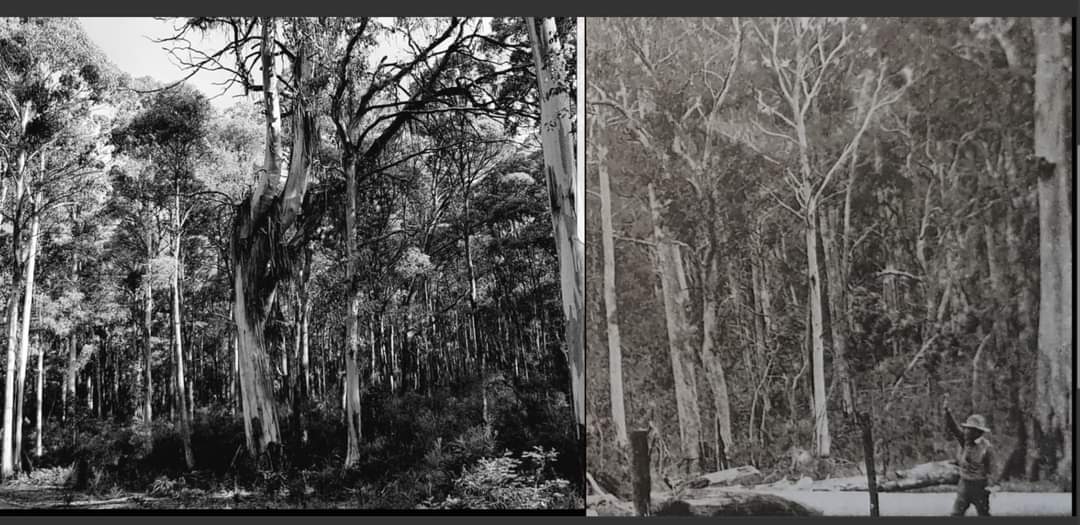
Jim, unless I am mistaken that is a photo taken close to your “Starburst Tree” aka PC4 and it is around 70 meters further away from your claimed Campsite and PC1 2 and 3, which is where the Burman photo was taken. S0 these two images are hardly comparable.
In any case this tree, PC4 is not visible in any Burman photo and is the one your team DREW on the images to try to make the case for its existence. You drew it in because you found a tree in a place where you needed there to be one so you drew it in and have tried to convince all and sundry that what youve drawn is something that can be seen on the photos. It simply CANNOT be seen in the photos. All that can be seen is a confusing tangle of branches and foliage that you have connected in a particular way to conjure up a tree, The ‘trunk” of PC 4 simply cannot be seen where you have drawn it, or anywhere else for that matter. This claim by you is a complete fabrication.
IN regard to the slope, I really do wish you would stop playing this silly game about slopes. EVERYONE from ALL TEAMS who looked at the Burman photos until the KTG Report appeared, AGREED there was an obvious moderate slope close at hand to the logs that rose quite quickly to a height of a few meters, which is in perfect accord with the eye witness report who said the tent had been at the foot of the slope and it ascended immediately behind the tent. In your report you DISMISSED those claims and said what was interpreted as a slope immediately behind the logs was a photographic illusion, pixellation created by the movement of leaves, that everyone else who said that a slope was visible was wrong. By contrast, there is NO SLOPE of any significance between your “Campsite” and PC4 – I believe you claim there is a rise of maybe 3m over that distance which equates to a slope of barely 4 degrees, and if you go there, as I have on two seperate occasions, no slope is apparent to the naked eye. To now claim a slope exists is completely disingenuous : yours is a technical map-defined ‘slope’ but not a slope in the ordinary sense of the word, its not a ‘slope’ that an observer would notice or bother recording, and the ‘summit’ is a long way further back than the one everyone else, including the eye-witness has identified .
Sorry David, I’ve only just seen this comment of yours. I do agree with Bill that your blog is cumbersome and sadly some good comment & opinion is easily missed. Time for an upgrade? So now you say the Starburst tree is 70 yards away so our slope is not relevant to the topic? Yet you argue possible fences on that same slope is? The professional photographer who wrote a report for us stated a portrait lens shortens the depth of field. His report is very interesting and we didn’t know him prior and nor was he paid. You do vocally call for expert opinion but isn’t it important we take that opinion on board?
Hi Jim, I don’t think anyone can make any comparison out of these two images. I had made comment about this re- your report in Jan 2020
https://www.ironicon.com.au/de-fencing-the-ktg-report.htm
or as attached
Attachment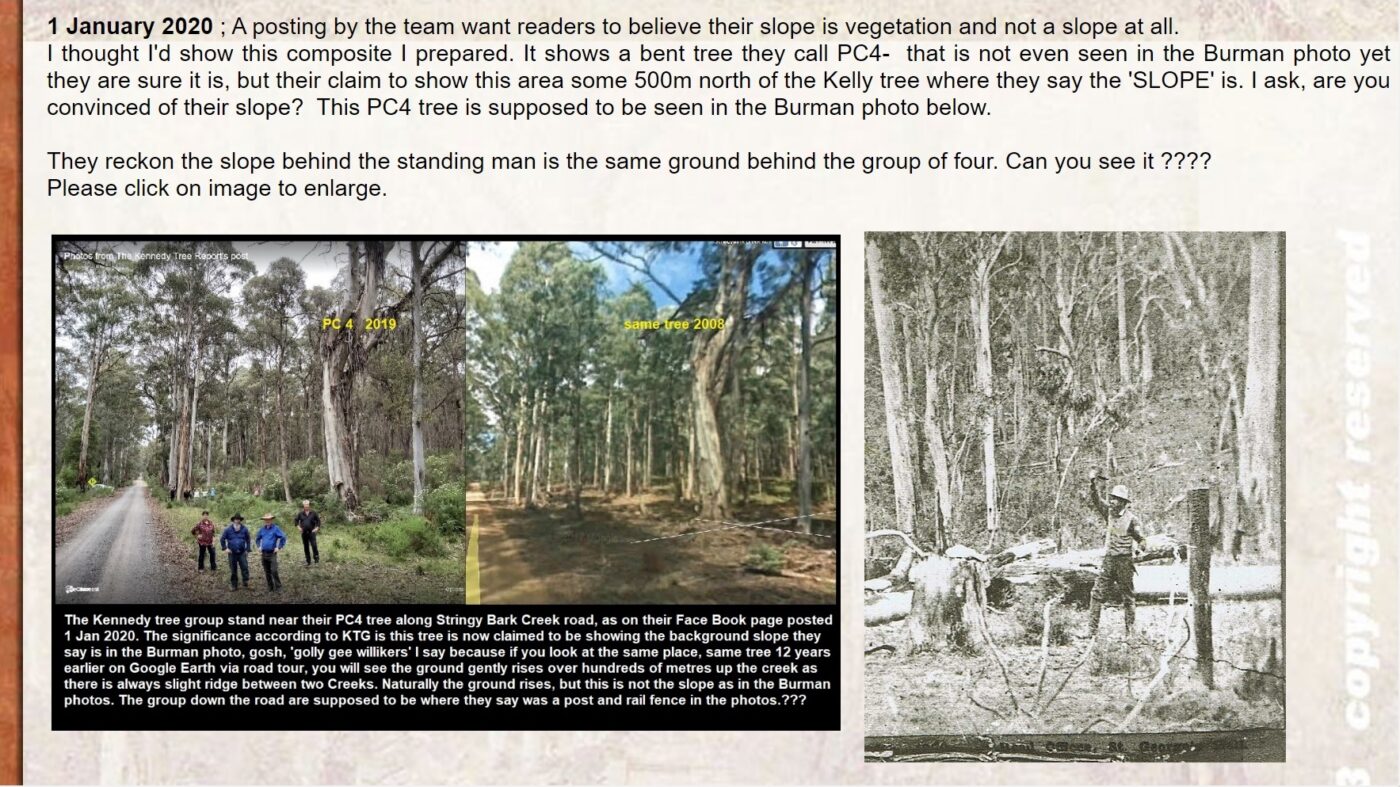
If you had read it before why did you insist that a constable went along when it was clearly Burman, a local guide, Monk, and reporter in the party of four leaving Mansfield? We have been over that in previous comments, I suppose. I never looked for or found article before as I am not interested in the SBC aspect of the story nor am I interested in the exact spot, so I have no dog in this fight!
Hi Sharon ,
We knew all the four but didn’t know the policeman’s name and only referred to him as a policeman as we knew he knew the area as well and most likely was on one of the search parties. I find SBC the most interesting part of the story as I believe it was the turning point were they could not go back.
I am sorry for not following most of the blog and only look in from time to time because it just seems to be covering old ground and going round and round.
The reason I stepped up to committee to our site was that it was getting nowhere years ago and unfortunately that’s still the case now.
I only became aware of these posts in 2018 and so much went on before that.
So after all this so far have we worked out if the sketcher was with Burman or not..
Yes, we have proved someone wrong who insisted that the artist was on site. Still interesting to read all of the other stuff. I am fascinated by the journey they took to get to the spot, especially with all of the camera equipment being in peril. I wish someone who had seen it earlier would have turned everyone else on to it as it is some good reading. No one thinks these days of how relatively easy in comparison it is to get to SBC and take along a phone or digital camera. Those guys did it the hard way. Took dedication and guts and I suppose for the photographer it was not all just to document but there was the incentive of hard cold cash to be made.
Hi Sharon, it also seems in some of the comments that there is an assumption that the un-named guide was a policeman, but I suggested above that the article’s point that someone found a local who knew the area to be a guide for pay counts against that. What do you think, if you wish to discuss that question?
I sure do want to discuss it! I am in agreement with you as to the guide being a local civilian. Everyone seems to think that they needed an armed constable or trooper to go along for protection, but in those days most of those folks were their own “homeland security” and excellent hunters and had plenty of knowledge of how to use the weapons they owned. Also, others knew their way around the area and not just the troopers involved in the search for the bodies. I will put the cut and paste of the pertinent bits so everyone won’t have to go back to the article. –
“It is difficult for people at a distance to
fully understand the scare which the recent
tragedy at Mansfield has caused among a
number of the residents in that district.
Every drunken loafer who is in his cups and
talks wildly is at once put down as a friend
of the Kellys on the look-out for information.
The probability or otherwise of the gang
attacking Mansfield is freely discussed. It
is with great difficulty that a guide to the
scene of the murder can be obtained. An
artist from one of the Melbourne illustrated
papers was anxious to visit the scene, but he
found great trouble in procuring a
person to show him the way to it.
The more so, as one half-drunken
individual, on the day of Kennedy’s funeral,
remarked that the artist looked like a police
officer. This gentleman and myself, how-
ever, were determined to visit the scene,
even had we to be our own guides. The
weather, however, was so fearfully bad
that it was quite impossible to stir
out. At this stage an enterprising
Melbourne photographer, Mr Burman, arrived
at Mansfield, and, as a photograph of the
scene would suit him equally well, the mili-
tary-looking artist left Mansfield. This
knight of the camera, after some hunting
about and invoking the aid of one of the
principal residents of the district, found a
man who knew the country and who was
willing to supply horses and run the risk of
a bullet for a given sum. This man was en-
gaged. “
Sounds like Monk
Hi Jim, it can’t be Monk as he is separately listed as one of the 4 with Burman.
Four who left Mansfield were the reporter, the photographer, the local guide and Monk. They met a trooper along the way who assisted at the river, but he was not of the party of four who headed out. Here is a pertinent bit to help clear it up once and for all – . “Just as we
were preparing for the start, Ned Monk, of
the Wombat Creek saw-mill, came into the
township, and at once consented to house us
for the night and take us to the scene on
the morrow. Some demur was made, not by
Monk, to my appearance, as, dressed in a
white macintosh coat, with patent leather
leggings, and riding a big grey horse, which
once belonged to the Government, and still
bore conspicuously on his shoulder the Crown
brand, it was considered probable that I
would be taken for a police officer, and if
met by the Kellys the party would be all
shot. However, all difficulties were at last
overcome, and four of us (ominous number)
started.
THE ROUTE.
The scene of the tragedy is in the Round
Camp Ranges, about fifteen miles north-east
from Mansfield, as the crow flies ; but owing
to the circuitous route necessary to get over
the ranges, the distance to be tra-
versed to reach it is about twenty-
two miles. The way lay through the
Mount Battery Station— and here a Mel-
bourne man has brought home to him in a
practical manner the Closed Roads question.
After a ride of about six miles over some
excellent, well-grassed country, and after
crossing a couple of small creeks, we reach
the Broken River. This usually is a small
stream of some ten yards wide, easily ford-
able. Now, however, swollen with the
recent’ rains, it was a boiling,
surging, angry mountain torrent. There
was nothing to do but to swim it
or to turn back. We decided to do the
former, and Monk at once plunged his pony
in and got safely across. Our guide followed
with his pack horse, on which was Burman’s
camera, and also got through. The pho-
tographer, however, had rather a narrow
squeak. He did not, perhaps could not, keep
his horse’s head well up the stream, and
looked in some danger of being swept away,
that a trooper, whom we had met, and who
returned to see us safely across,
plunged his horse into the stream.
Burman, however, had got out of the swift
current, and his horse landed him safely. I
came next, but my horse, an old trooper,
was used to the work, and at once struck
out like a duck. Beyond the cold bath we
were so far right.”
Yes I’ve just re read the article and can see what you are saying. So the guide was ‘one of the principal residents of the district’ but goes anonymously for whatever reason. They had a rifle as you can see it in the police camp photos which is interesting as there weren’t many around. Monk would have been the best guide for the party to have. So there must be something relevant about the other guide that they needed or wanted. Maybe the rifle? Or is the other guide a policeman who doesn’t want to be identified as he accepted money to take them up? Strange they would need a guide when Monk was the best guide they could surely have….interesting stuff
The guide supplied horses, also. Maybe they did not know Monk was available or how to contact him as he lived 12 miles from town and it was just a fluke that he came into town while they were there. Also maybe Monk did not have extra horses to spare or to let? Waiting for someone to suggest that the guide was a former policeman, anything is possible. lol Maybe the reporter felt it was not of any importance to name him? Not a conspiracy at all. He did not know we would be having this conversation well over a century later, though!
In brief…. The special reporter leaving Burman to photograph the various scenes, stuck across country to meet up a police patrol.
Spent all afternoon with patrol then bade them good evening and pushed on to Monks place, which he reached safely shortly after Burman and his guides had arrived.
He then goes on to say:
The photographer, the guide, a constable and myself reached Mansfield in safety, much to the delight of the folks there, many of whom regarded us as mad for travelling four together, as by doing so, in addition to being shot down by Kelly, as troopers, we ran the gauntlet of being fired upon by troopers, as Kelly gang.
That’s right, a constable did not leave Mansfield with them but was met up with later on for the return to Mansfield. Four left Mansfield including Monk earlier that day, including reporter/guide/Monk/Burman. On the way back Monk just stayed at his place 12 miles from town as they had the guide to take them back in and the trap went along, so four returned. It is perfectly clear that the trooper/constable/trap did not leave with them but returned with them but was not at the scene for photos.
💯, it is perfectly clear and in plain English, and I can’t see why anyone ever wanted to complicate it.
I’ve been somewhat preoccupied with actual work lately and havent been closely following the thread until now when I just read it through from start to finish, and it really was such a pleasure! As you said Sharon this is what we get a kick out of, even though its not a very important issue its the joy of problem solving, of tracking down the relevant bits of the puzzle and seeing them all finally fitted together to reveal the picture…which of course is just another piece of the even greater puzzle we are all working on in trying to understand Stringybark Creek and then the big picture, the entire outbreak.
In this case it was interesting to see how it was always wrongly assumed that the four who went out from Mansfield was the same four who came back – that they picked up Monk more or less by chance, dropped him off and returned with a trooper, the Artist came and went after learning that photos were going to be taken and therefore he had nothing to gain by going up there, and I especially liked the description of the four of them crossing the flooded river, with a packhorse carrying Burman’s equipment.
Fascinating stuff!
Incidentally I had read and referred to that Nov 5th 1878 Herald Eyewitness account as far back as 2019 but my focus back then was on the statement that no fences were erected at the camp site, something which contradicts the Kennedy Tree group claim that they can see fences in the Burman photos. There are a lot of gems in that report, as Bill has been reminding us, because its not just the report about the absence of fences that undermines the Kennedy Tree groups claim to have located the Police campsite : its also undermined by the description of the slope ascending immediately behind the tent.
Lastly do we all concur that the Sketcher artist very likely worked off the Burman images, that he didnt go up there, and the shadows that he highlighted mean the photo MUST have been taken looking towards the south or southwest as Bill has always proposed?
Hi David, I’d like to see the Sketcher picture side by side with the Burman photo that’s closest to it. My impression is that the Sketcher picture is a wider view than Burman’s. Sorry about not having time to do that comparison myself yet, but if my recollection is right, that the sketch is a wider frame, then my earlier suggestion might have merit; that maybe it was taken from a different Burman photo other than the ones he turned into postcards. After all, it’s a long way to go for only two photos if one of them proved faulty. The article said the artist could use a photo; my question is what photo might he have used. It is clear from the article that the sketcher didn’t go there with Burman’s group.
As for the other question about shadows and the campsite location, I’ll keep out of it and leave that to people who specialise in it.
There you go Stuart. Yes, the Sketcher image frame is a bit wider, so the end of the log on the right is visible but further across beyond that its fairly generic sort of bush and spear grass. The resemblances between the photo and the drawing are striking, and now we know the artist decided not to go up to SBC because he knew photos were to be taken, its quite clear to me what image he was using to create his artwork for the Sketcher .
Attachment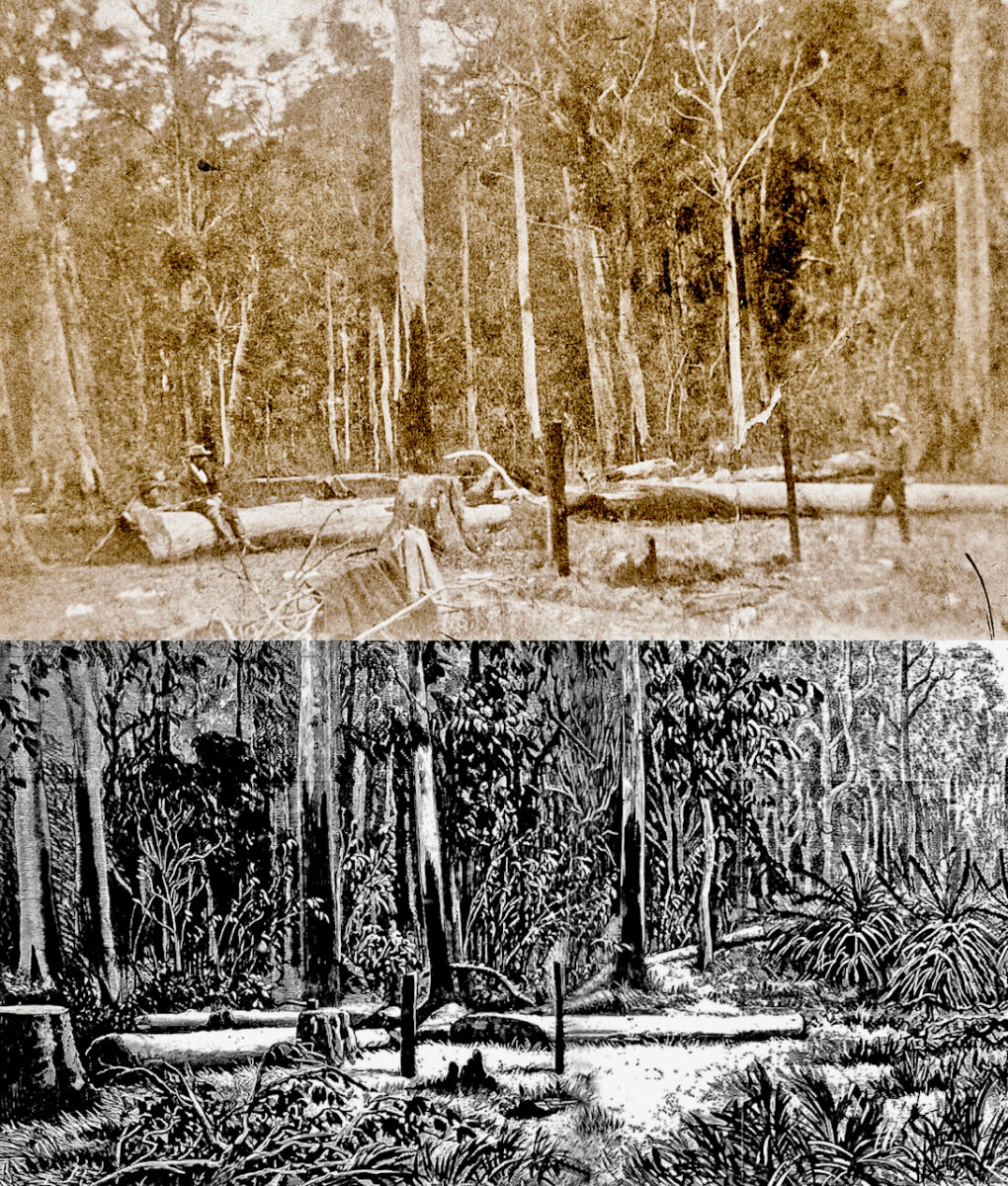
But an artist did go at some stage. That we know, what we don’t know is did he draw the pic that we are all talking about
And David please
These fences
The reported never mentioned Two piles of rocks
It is easy to see who you favour
Adrian , the white horizontal and vertical structures in the Burman photos that you claim are fences, and everyone else says are fallen saplings are easily seen in the photo. They would therefore have also have been easily seen by the Reporter on the spot, and if they had been fences he may or not have mentioned them. However, he said that the site had been cleared for a horse and then quite deliberately made the point that NO fences had been erected on the site, indicating that he had actually taken a moment to look around to see if any were there, but he saw none. If they HAD been there and he missed seeing them , that would imply they were not easily seen and yet those white horizontal structures are prominent. The eyewitness statement is unequivocal, and there is no reasonable case to be made for any other position than that there were no fences there.
Surely there can be no better way to resolve a dispute about what is seen in a photograph by people who werent there, than to seek the testimony of someone who WAS?
If you are going to adopt a posture that permits dismissal of even the clearest of statements from an eyewitness , how on earth are you ever going to be able to claim that anything that an eyewitness says can be relied on? One has to have a standard approach to these things thats applied consistently. An Eyewitness can of course get things wrong, but to dismiss an eyewitness claim there has to be good reason, and wishing he had said something else , or not mentioned something that he did is not sufficient .
I am not sure why you refer to the fact that ‘the reporter never mentioned Two piles of rocks’ – but if youre suggesting that this means they werent there, that is a mistake. NOT mentioning something is not the same as mentioning something specific and saying it wasnt there – NOT mentioning something leaves the question wide open : it is consistent with piles of rocks Not being there, and its also consistent with piles of rocks BEING there.
But to respond to your assertion about whose side I am on – as Ive said before, now we have the Burman photo orientation agreed on, this leaves. only two sites as contenders, your groups, and Bills. Your groups claim about the Fences and other claims your group makes about the photos, demonstrates to me a very flawed approach to photo interpretation, and I also think refusal to accept the clear testimony of an eye witness damages your teams credibility.
All of that is a fair call and I fully understand where your coming from.
As a team all four of us in our team looked closely at what we believed we could see at that distance in the Burman photo.
We all agreed that what we saw were rails making some form of fence or yards.
When you said no one else can see them, that’s not correct. Many other have also agreed with our statement about those saplings.
However I also understand that others may have a different view and it seem in this case the reporters statement says that.
Nobody is perfect and we all make mistakes.
But as I have said to you before it is our interpretation of what these saplings are.
In the end we all agree they are sapling we just said that we believed they formed a type of fence or yard.
Personally I think your making to much of this as it doesn’t alter what and where our site is.
Not any of the other site contenders are 100 % right and we are not perfect either but I would hate to think that locals have keep this quiet for so long and now most of them have gone we will have an incorrect site declared as the real site because we think some sapling form a fence 70 yards away in a windy blurry photo.
So David are you saying the police camped on that slope, 100m away in the background of the Burman photo?
No Jim I didn’t say anything about the slope or the tent. What I said was that the eye witness looked for fences and didnt see any, and this must mean that your teams belief that the easily seen white horizontal and vertical structures are not fences but something else.
But wasn’t he talking about the area that had been cleared where they camped hadn’t been fenced? He didn’t say there weren’t any fences anywhere in the area. And why did he even mention fences? But anyway whether there are fences or not doesn’t impact our Police camp site. You keep using this argument to prove we are wrong but it’s a baseless argument don’t you think
No Jim the eye-witness didnt say anything about fences where the police camped : he was referring to the entire area, which he described as a paddock : ‘the site that has been partially cleared as a paddock for a horse but no fencing was erected.” Its really very clear.
You ask why he even mentioned fences : nobody knows is the short answer but I would guess as he believed the space had been cleared as a paddock for a horse, he expected to find some but was surprised on looking around not to find any.
And no I dont think the argument about fences is ‘baseless’ or has no effect on your claim to have located the site because that claim rests entirely on your ability to correctly interpret whats seen in the Burman photos. Getting the fences claim wrong calls your interpretive abilities into question in my opinion.
Actually, David I have just read the article again. The reporter is talking about the hut site that was burnt down (the 2 burnt posts in Burman photos)…..;the site has been partially cleared as a paddock for a horse, but no fencing was erected.’ So he is specifically talking about the site where the black vertical posts are- not 100m away in the background up that slope. And sorry your argument on this is odd because what if we now said we were wrong about seeing a fence in the background – does that automatically mean that our police camp site is correct now? Is that really the argument you propose? Come on David- whether there is a fence or not in the background has absolutely no bearing on our police camp site. And given the reporter is specifically talking about the hut site that had been burnt down, if there was remnants of a stone fireplace there, why didn’t he mention it? He surely would have tripped over the thing if it existed- surprising too that the first search party in the dark of night didn’t fall over it and injure themselves too? I am interested in what you think about the stone fireplaces- David do you really think the stone fireplaces exist and what evidence is there to support they exist?
Hi David, thanks for putting those pictures up. I’m feeling even more strongly now that Burman likely took the wider framed photo first, which was used by the sketcher, then moved his camera further in to focus on the murder scene with the actors, which became the postcard photos….
Just speculation I freely admit, but plausible….
The related reason is that if the sketcher artist didn’t have a wider frame photo to work from than the two Burman postcard photos we know about, he would have had to invent the wider left and right hand parts of his etched bush scene. This would expose him to criticism from anyone who knew the location including Burman but also Mansfield locals and police and others such as the special reporter (Hall?) who had been through the area. Yet there don’t appear to be any criticisms of his sketch back in the day.
I have asked Adrian Younger to show a picture of their police camp site comparable to the Burman photo, and agrees their site is gentle undulating ground sloping north. Okay, yes we all agree ground between creeks eventually slopes down to the creek. However, what we are talking about is a particular little hill with a strong slope from which a reporter in Nov 1878 said: “overlooked the police tent.”
Are you going to show us a picture of your site comparable to the Burman photo?
Sorry Bill but not many of my question here are being answered.
I tried to seed a pic the other night but for some reason would not load.
What is interesting is this little hill is there and fits the reporters disruption however it’s not in the Burman photo.
It’s behind the camera.
The photo only shows a small part of a 360 degree circle.
The reporter had not seen what the photo was going to show so he is taking down all he can see about the area.
Remember this little hill must be north of the camp as he says how the creek winds around it in the direction of the King River
Hi Adrian, You agree the Burman photo is looking southerly, and you are saying that the ‘Reporter’ was standing on a slope of a little hill when “overlooking the police tent”.
So you are saying that the reporter was on another little hill ‘looking down onto the police tent’ while facing south with not relationship to the Burman photo ?
Please show us your picture.
Well yes is that not what he said. I don’t have a good photo of this and I don’t seem to be able to post it.
It’s all there and fits all photos taken over the last 145 years.
Looking S/SSW from the little round hill, and it is little and round, over the police camp up the northern slope to a high point just north of the current toilets. This is where the Kelly’s watched over the PC with the spring to the south of them.
This little round hill is what Kennedy and Scanlon rode over as they entered the PC and were bailed up.
I will be up a SBC again very soon clearing the track into Bullock creek and will try and get some better pics.
I may just send them direct to you. That would be easier.
Hello Adrian, email me the image and I will try uploading it here.
You say you are going to clear the track into ‘Bullock’ -re Kellys Creek.
Can I ask for what reason? Why don’t DSE or DELWP or whatever they now call themselves these days and poison all those blackberries to the end???
Its pathetic that back in 2005 or so, they ramped up an earth mound to stop cars into the area- this was after I had nominated the whole area to Heritage Victoria.
As a matter of interest: This blog is rather useless if it gets too many replies to one posting.
Here is what David wrote- but appeared as one long alphbetic string-
DAVID posted
06/10/2023 at 12:45 pm
No Jim the eye-witness didnt say anything about fences where the police camped : he was referring to the entire area, which he described as a paddock : ‘the site that has been partially cleared as a paddock for a horse but no fencing was erected.” Its really very clear.
You ask why he even mentioned fences : nobody knows is the short answer but I would guess as he believed the space had been cleared as a paddock for a horse, he expected to find some but was surprised on looking around not to find any.
And no I dont think the argument about fences is ‘baseless’ or has no effect on your claim to have located the site because that claim rests entirely on your ability to correctly interpret whats seen in the Burman photos. Getting the fences claim wrong calls your interpretive abilities into question in my opinion.
To which Jim replied-
JIM FOGARTY REPLY
06/10/2023 at 3:10 pm
Actually, David I have just read the article again. The reporter is talking about the hut site that was burnt down (the 2 burnt posts in Burman photos)…..;the site has been partially cleared as a paddock for a horse, but no fencing was erected.’ So he is specifically talking about the site where the black vertical posts are- not 100m away in the background up that slope. And sorry your argument on this is odd because what if we now said we were wrong about seeing a fence in the background – does that automatically mean that our police camp site is correct now? Is that really the argument you propose? Come on David- whether there is a fence or not in the background has absolutely no bearing on our police camp site. And given the reporter is specifically talking about the hut site that had been burnt down, if there was remnants of a stone fireplace there, why didn’t he mention it? He surely would have tripped over the thing if it existed- surprising too that the first search party in the dark of night didn’t fall over it and injure themselves too? I am interested in what you think about the stone fireplaces- David do you really think the stone fireplaces exist and what evidence is there to support they exist?
But Adrian please reply to my posting
06/10/2023 at 5:56 pm – re the photo of your suggested SBC site.
Hi Bill
I understand your frustration at the way the blog works when they are many replies…but I have no control over that. What a pity the Toad Mick Fitzsimons took it upon himself to wreck three attempts by me using a different Forum structure to. have discussions that were much easier to follow.
I guess the good news is that as he backs the wrong interpretation of the Burman photo orientation he has dealt himself out of the conversation from this point on.
This Blog was supposed to just be about confirming that the orientation of the Burman photo was what youve been claiming for a decade. I have been surprised that no CSI member ( ie Glenn ) or the Toad has involved himself in these conversations….not even to concede that yes, your Camera placement claim is the correct one. But I think we have nailed it well and truly. They are speechless…
The conversation here has wandered off into discussions about what is SEEN in the photos.
I had intended making that the subject of a seperate Post actually, and I will get around to it so in the meantime, maybe have a read of Stuart Dawson post about the Hub and see what you think.
David, it did seem as if we, the inmates, were running the asylum while you were otherwise occupied! Have to agree, the comments are good reading with all sorts of different aspects being explored and discussed, all without anyone being rude or nasty, imagine that! Yes, as Bill said it is hard to follow this format, but I do like that we are not stuck on one subject and can branch off like we have as it has been a goldmine! I had forgotten you had quoted from the Herald article regarding the fences a while back, but I don’t pay much attention to SBC stuff usually. It seems that all sorts of people can read all sorts of articles and some things just jump out at certain people at certain times. It is all good. Also, sometimes the so-called experts and/or book authors who are not “experts” get it wrong. We others get things wrong, too, but we learn from it and keep on going, that is life! But as said, it is fun to try to figure it all out. To Adrian, what or where is the source for the artist *eventually* going to the SBC site? Stuart, to be sure more than two photos were taken, I am not sure how long it would take to do one pic but he probably had several he did not use, just picking the best for the postcard series.
Hi Sharon,
My 2nd post to this blog at the very start that no one must have read referred to Brian Carroll’s book on Ned Kelly 1976
Page 76 to 80 mentions an reporter that travels into SBC.and bullock creek with a guide not long after the murders.
He talks about doing some sketchers.
Worth a read.
Hi Adrian, Carroll’s section about the reporter going to SBC and the description of the fortified hut of the gang doesn’t give a source reference, but it is taken from the Argus, 13 November 1880. The article begins, “The following description of the fortified retreat of the Kelly gang is supplied by a trustworthy correspondent:―
Leaving Melbourne one day last week, I took a train to Longwood, and from thence coached it to Mansfield, the township which derived so much notoriety through the outbreak of the Kelly gang. Procuring a horse well used to rough country, and obtaining the services of a guide, who, I may state, was intimately connected with the Kellys and their friends, and had undertaken to conduct me to several of their haunts, I started early in the morning from Mansfield….”
All the article says about the SBC murder site itself is one sentence: “Traces of the murders are still visible; on every side are bullet-marked trees, and a few old posts of Walter Lynch’s hut can be noticed almost in the centre of the cleared space, which the Kellys and their confederates approached by creeping up under the shelter of the tufts of spear-grass.” It moves straight on to the fortified hut: “Whether Kennedy was aware of it or not, all the time he was retreating … he was making in almost a direct line for the hut in which the Kellys and their mates had lived for many months before they committed the crime which caused their outlawry.”
Then their is a lengthy description of the fortified hut, and the article ends, “I did not attempt to inspect the country in the vicinity of this stronghold of the outlaws. By the time I had taken a hurried sketch and picked up a few interesting relics, it became time to think of turning homewards; so only waiting a few moments to inspect the track which led from the hut across the creek and over the gap towards Greta, my guide and I turned our horses’ heads southwards, and after a rather rough ride reached Mansfield late at night, from whence I took a coach to Longwood next day, reaching Melbourne the same night, none the worse for my trip in the Kelly country.”
The report is actually two years after the murders, and the reporter took “a hurried sketch”, presumably for a personal memento as nothing is heard of it elsewhere. So yes, a great article, but not any help with regards to anything about the SBC site.
Thanks for that, Stuart. I have a copy of the book but cannot lay my hands on it right now. Two years later and not with the party who went earlier and had Monk along, as no artist went on that 1878 trip, good work. Adrian, I sometimes skim over comments that have to do with SBC (saplings and slopes and angles, oh my!), so I went back and looked and you mentioned a correspondent not an artist, therein lies the confusion I had. No worries!
Yes it is very interesting but he admits that he was sketching,
My mistake that I didn’t notice that it was 2 years later.
Hi Stuart, is there any mention of ruins of stone fireplaces where the police camped in that article?
Hi Bill, I have a couple of back to basics questions/observations for which we have gone over previously. But feel they need addressing here. Question 3 is a fresh observation.
McIntyre:
1.”We made the fire in the opening about 20 yards from the tent where the logs crossed each other.”
“These two logs thus formed two right angles, the point of junction being about 25 yards from the tent.”
”There had been a hut on the clearing, but only the remains were left standing. We camped in a tent a few yards behind the old hut.”
Clearly the tent location as shown is not a few yards behind either fireplace/hut.
2. McIntyre: “The entrance of the tent was facing east and also the creek which was about 70 yards distant.”
The tent position shown on the scaled map is only 47 yards (43mtrs) from the creek. Give or take a few is understandable but 23 yards shy is way out.
This also indicates that the logs/fire location is too close to the creek.
3. Reporter:
“At the top of the slope and overlooking the police tent, was a clump of scrub and sword grass, some sixty feet in circumference, (approx. 7yrds in diameter) and in which a dozen men could easily conceal themselves. Standing a few feet in front of this clump of scrub but still overlooking the police tent, are two bunches of sword grass, four feet six inches high, and presenting a covering surface of some six feet. It was from behind these bunches of sword grass that Kelly and his confederates called upon the police to surrender.”
Comparing the location of the sword grasses on the scaled map 1 to the photograph 2. The campsite/logs are on lower ground than the tent. Any sword grasses in that area would not overlook the tent. When looking towards the south at the two hut site the slope rises from the left (red line) towards the west 18 and top of the slope. (Roadside) I would expect the sword grasses to be near that location at the top of the slope. Or the little hill shown on the map. Ref: SBC-1234.jpg
Glenn
Hi Glenn. One thing I notice in your quote is that McIntyre says the two logs made two right angles. Elsewhere he said there was a log running north-south and another running east west. I think we can ALL agree these statements of his are very imprecise, or, if you want to be super critical you might say they are wrong…but I dont think any of us DOES say he was “wrong” , we say instead we know what he was getting at, his claims about angles and orientation were guesstimates remembered from a period of intense stress and fear, and we work with them to get the best possible fit. The same has to be applied to distances and I do NOT think a difference of 23 yards ( your point 2) is too much to accept as a ball park figure. ( Just recall how wildly different the estimates various people made about the distance Kennedys body was from the camp – up to many hundreds of meters and yet Adrian and Jim say it was only 2 hundred meters…)
In relation to the Reporters words I think a clear distinction needs to be made between what he OBSERVED – such as clumps of sword grass, slopes, etc – and what he ASSERTS or CLAIMS about where something may or may not have happened. So exactly where the Gang emerged from sword grass is speculation by him isnt it?
And can I ask if you are willing to concede that the discussion about the etching and the shadows clearly drawn settles the argument about the Burman photo orientation? To maintain your former position you would have to add the artist to your list of who got everything wrong – Burman got his actors in the wrong place, the artist got his shadows in the wrong place, and even McIntyre who said the photo showed the ground where Lonigan was killed was wrong…all on the basis of your claim to have identified a Burr in the Cuddon photo that you say is the same one – though entirely different looking one – seen in the Burman pic…
Hi David, by following your logic if Monk new where it all happened then he would also have told the reporter where the sword grasses were and from what area the Kelly’s first bailed up the police.
We also have the comparative distances of the reporters and Mclintyre.
Glenn.
Glenn what I am getting at is that in all of this there is a certain imprecision, and therefore it makes no sense to insist that a particular estimate of distance or of direction or the second hand report of Monk to a reporter about exactly where certain things happened is completely reliable.
However some things are certain ; for example those shadows make camera orientation from the southeast impossible. Are you ever going to concede?
Hi David, as l mentioned previously both Mclntyre’s and the reporters distances are very close.
Reporter:
“Mclintyre was at the fire cooking this was precisely 39 paces from the foremost bunches of grass”
Mclntyre:
“The four men were in a line and two or three yards distant from each other and the same distance about 40 yards”
Reporter:
“The tent stood exactly 25 paces from the foremost bunches of grass”
Mclintyre:
” On your right or south side of the clearing……..afforded good cover to within 20 yards of our tent for any party wishing to attack our camp, and was from this position we were attacked”
So we don’t have to rely on Monk. Even though you have said that Mcltyre would have told him where it all happened.
Glenn
Attachment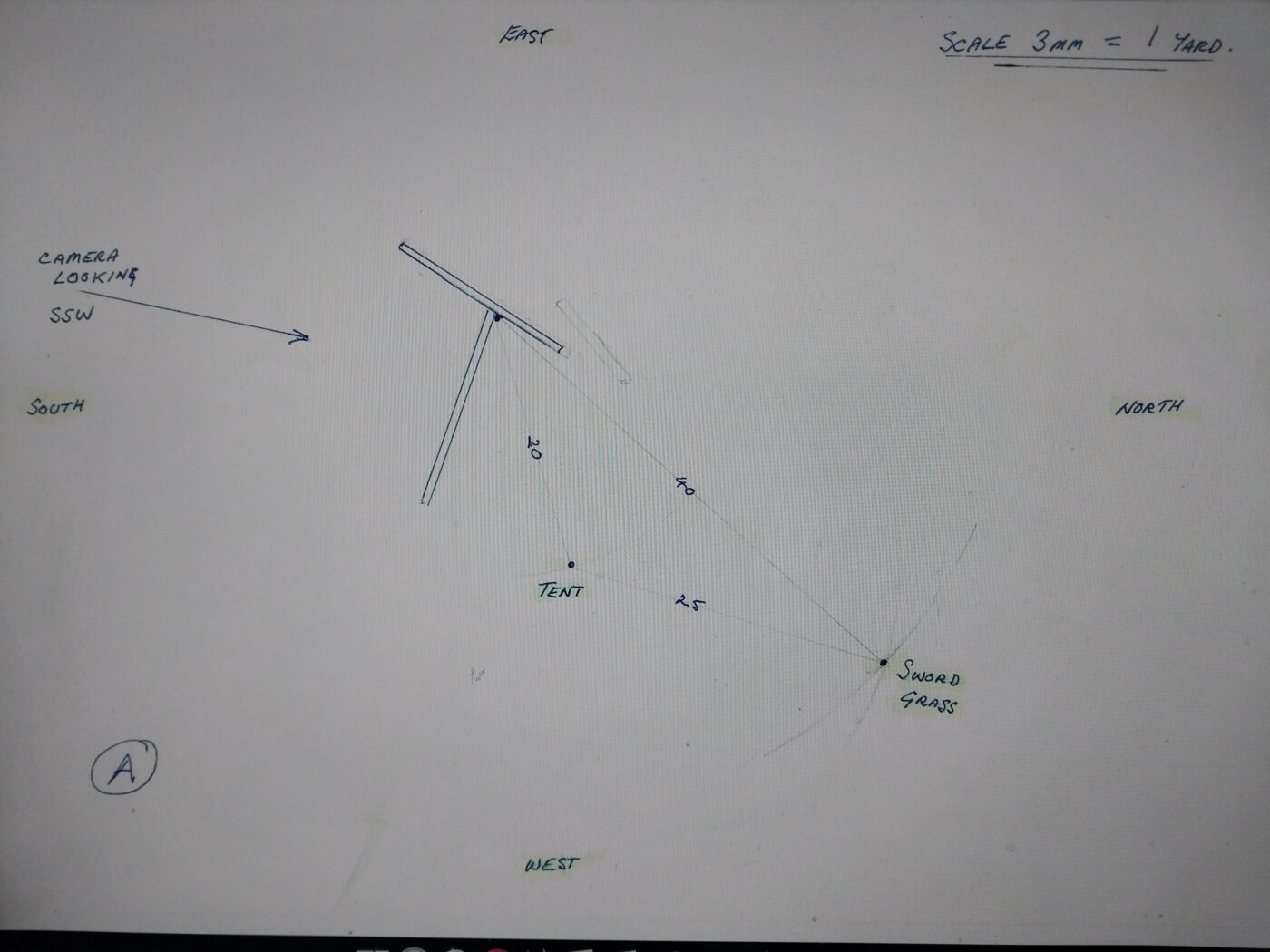
RE above attachment. Yes. Just noticed North should be South and visa versa. But am sure you get the idea. Glenn
Glenn: Following a few more of your 3 points,
McIntyre did not draw a hut site on his map. He might have written that their “tent was a few yards behind the old hut”, but how do we interpret “behind”?
If the remains of a hut had a front like a car, a side, and a back, what determines the front of a hut? e.g., the creek side, or the approach to the hut from the bridle track?
On my scale map, I could have drawn the tent right ‘behind the huts fireplace2 ‘ but then you would say it was too close to the fire and logs.
My model analysis of the Burman photo logs clearly shows the logs form a distorted Y and not a right angle, but if you look at my https://ironicon.com.au/images/SBC-1234.jpg
and observe item #3, (the view from the tent) -the V looks like a right angle just as McIntyre remembered.
Regarding your comment 70 yards, as said before -this could been an estimate by Mc after seeing the Burman photos while he was recovering and had to make a report. Remember also that the creek had been mined for gold and the creek water stream could have been artificially directed to the gold workings on the east bank and has since been forced back to the west bank. Having been a gold miner myself, I know how those miners heaps can completely change the terrain. There is also the issue of the existing SBC road construction, -how bulldozers changed the lay of the land reducing the flat area encroaching onto those two huts fireplaces.
Hello Glenn, you must be referring to this image-
http://nedkellyunmasked.com/wp-content/uploads/2023/09/mcintyres-map-at-sbc-2-huts.jpg
and re- https://ironicon.com.au/images/SBC-1234.jpg
However, each of our interpretations will vary, but I did produce a map to scale of where the two huts fireplaces are located. I know you are a CSI@SBC team member, and we don’t agree.
The CSI team never had any proof of 2 huts locations, and stick to 70 yards while this could have been a typo meaning 70 feet. If we take 70 yards, we never found the remains of any huts at 70 yards from the creek. Even latecomers like the KTGroup communicate about the two fireplaces as two piles of rocks as if they represent nothing of any significance. The fact remains, we each draw maps and draw conclusions, but I will be the first to admit I might be wrong on certain conclusions, but can conclude the Burman photos were taken looking southerly. Taken that at the two huts fireplaces, there is a slope and a swamp to the north, and that two 1930s locals also pinpointed the site, one being Bill Stewart, the area best fits all the criteria, let’s settle that the two huts best fits all the historical records best.
Hi Bill, if it was a typo and the 70 yards becomes 70 feet (21mtrs) then this would place the tent on the creek side of the logs and in front of the fireplace. So strongly doubt if was a typo.
Glenn
Shall we say 70 yards was an estimate by McIntyre – two years after the SBC event. We have photos, we know the terrain along SBC. We have the fireplaces of two huts, we have a steep rising ground (the road) west of the swampy boggy ground which is north of the two huts just like is reported at that time. We should agree the photos were taken looking southerly.
We know a White gum stump where Const Scanlan was shot was photographed during the late 1920s (in JJK’s book but a poor photo) that fits with what Bill Stewart knew about and had told me in 1985. This location was confirmed by Terry Scott who had no idea where the two huts were when he showed me where he found a big bullet, yet when he became aware of the CSI@SBC’s claim that their site was near the K tree, and a ducumentary was to be made, he decided to change bullet find his location.
We know the swamp area to the north of the two huts has slowly crept into the level ground reducing its overall size, just as the gold workings to the east, and the road to the west -have encroached that space. Nothing stays the same, so we have to take in all these things into account and stop nitpicking tiny details because everyone can get things slightly wrong, just like me.
The original landowners did not know any of the conflicting written details that this generation of historians are obsessed with. We have to look at the big picture and try to piece together what remains of the jigsaw, otherwise, we become completely bamboozled to the point where one day some one will claim that the police actually camped at Bullocks Creek and the Kellys camped at SBC. This is the sort of BS that some experts on other FB pages will be pushing just for their own ego-testical glory.
Glenn; Remember when the five of us got together for the purpose to sort this all out once and for all- and look what has gone on ever since. We had agreed not to publish unless we all agreed, yet I was pushed out of the CSI group because you, Kelvin and Linton wanted to release your paper at the Glenrowan siege dinner night. I still have a copy.
The authorities could not handle all the BS, and that is why they are free to do whatever they like. The general public knows so little of the story and will believe whatever voice is the loudest.
One day when we are all gone, a huge bushfire will tear through the whole area, and then everyone will say’ O M G’ Now we can see exactly where all this happened.
The picture shows one of the fireplaces covered with mess, and the same fireplace place today due to total neglect and care for historical accuracy.
Attachment
Hi Bill, it was you who invited me to participate in the investigation back around mid 2009. At the time was a green horn knowing very little about SBC. But having read Ian Jones book A Short Life. The descriptions of the camp and sketches made no sense at all to me. After driving everyone around me nuts talking about it I manage to find your web site, messaged your feedback page and it all went from there. When you first showed me the two hut site I remember being initially convinced it was right. It all appeared to make sense. Once Linton showed us around the Kelly tree site that too made sense. So it was not until after many trips to SBC and a great deal of study that I was sure that the Kelly tree site was definitely the place. The other team members, Kelvyn Gill, Gary Dean and of course Linton also agreed. The discovery of McIntyre’s diagram confirmed that it was the right location. There is no need to play around with his diagram to suit a particular site.
Without realising it you have only strengthened my belief in the Kelly tree location. You have no idea the number of times I have been to SBC just to check something. I’m sure we could debate for ages about wether there was a swamp north of the site…as this appears to stem from Ian Jones. The unreliable evidence of the bullet find. (By the way the CSI team made no contact with Terry Scott) Or McIntyre’s supposed trauma induced memory loss and directional confusion.
I really don’t like debating over SBC it stresses me out. It causes conflict between otherwise nice people. And I’m sure a lot of people are tired of reading about all the time.
But the current longterm site is signposted for good reason.
Glenn
Glenn I think a new consensus is developing about the photo orientation – the topic of this Blog Post – so I am interested to know if that gives you any reason to reconsider your CSI site claim, given that the Burman photo orientation is a basic building block of any attempt to locate the campsite?
Glenn, If you had read our investigation research paper that I had put together in 2009, linked here-
https://ironicon.com.au/stringybarkckinvestigation.htm
About halfway down the page under the heading- “Further information to the source material as follows”
is ref the Mansfield Shire President – James Tompkins ( or Tomkins) who wrote the report of finding Sergeant Kennedy’s body. He also mentioned the Police camp and wrote ” immediately north was particularly boggy ground” (swampy)
I do not have Tomkins actual text account at hand, but he stated that Sergeant Kennedy’s body was found about 1/2 mile North but to the East of SBC, and if we were to pace that distance out from the current Kelly tree area, – your CSI preferred site, then 1/2 mile ends up past the junction of SBC and Ryan’s creek, so together with the Burman photo orientation, your adherence to the CSI report does not stack up.
Attachment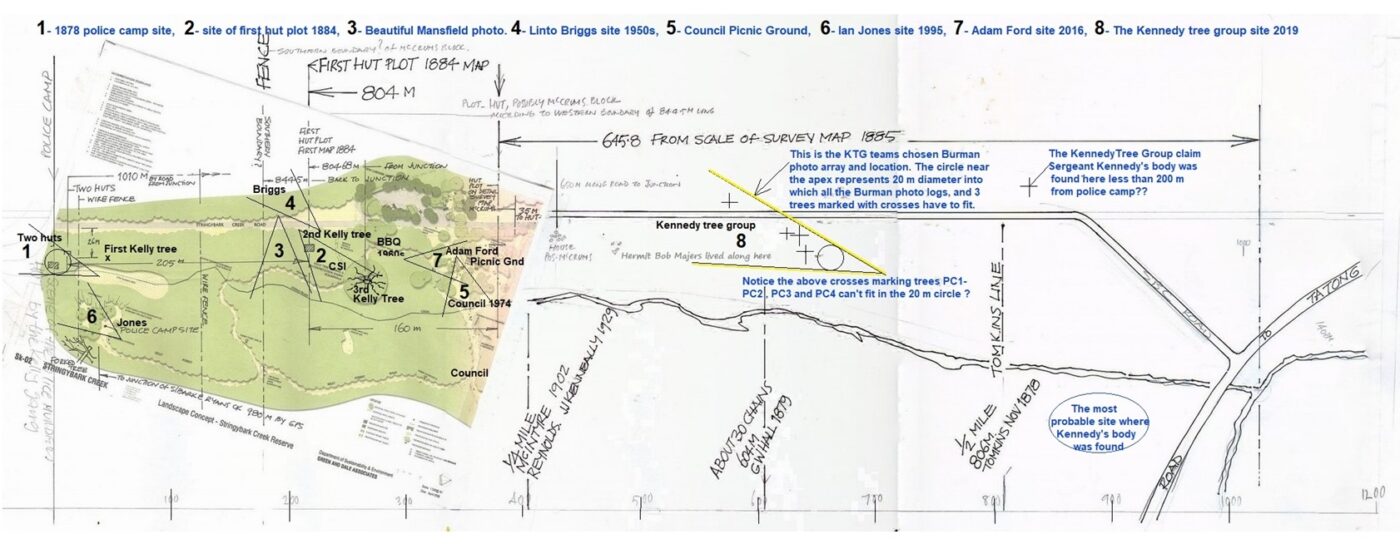
No David, my views are exactly as there were yesterday.
Glenn
Glenn it puzzles me why you dont find the argument about the shadows compelling. Can you explain why you think the artist got it wrong?
David, its obvious the artist drew his sketch based on the Burman photo, adding his own creative touches. Nothing compelling about it. There are no visible shadows of the posts in the Burman photos. Both Jim and Adrian are also of the opinion that the shadows in the sketch don’t represent the time when the photo was taken.
So I think your continuous argument about the shadows shown in the sketch is pointless.
Glenn
I disagree completely : there IS a post shadow in the Burman photo, and this is what the Artist picked up on, along with all the other shadows seen elsewhere in those images, that made it very clear where the light was coming from.
So on what basis do you and the Kennedy Tree advocates say. “the shadows in the sketch don’t represent the time when the photo was taken.”? SURELY the logical explanation for the shadows drawn is because they are what is seen in the photos, and therefore they DO represent the time when the photo was taken.. To stay otherwise because it doesnt fit your proposal is bad faith, and this is a particular characteristic of the KTRG mob – dismissal of any eyewitness evidence or photographic evidence that doesnt suit their theory.
Attachment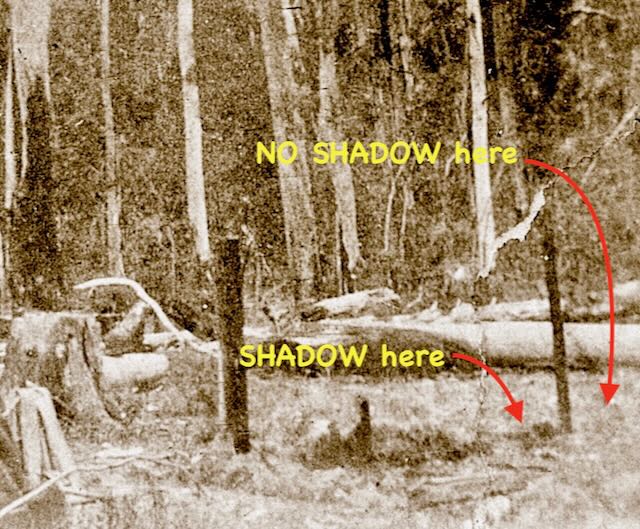
Also David can you show us the 2 stone fireplaces in the Burman photos? Jim
Hello Jim, here is one of the earliest photo comparisons from the KC2000 days. Bruce was an avid SBC researcher, and I believe it was Mick Fitzsimons ( Fitzy ) who took the top photo which has a large leaning tree, that tree has recently fallen over.
In the Burman photo, you will see the standing man’s boots are hidden behind a mound of collapsed fireplace stones and debri.
There are also the huts post holes in the ground into which Bruce placed some Polly pipe.
Attachment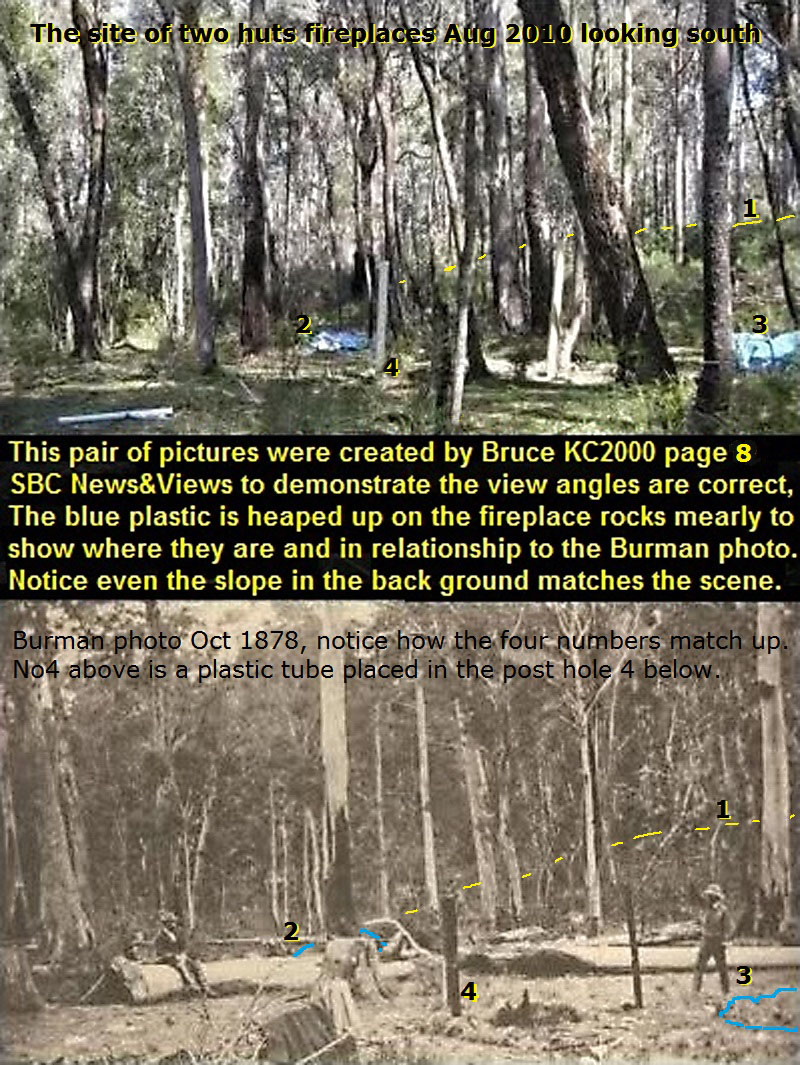
Thanks Bill.
David, do you see the collapsed fireplace in this photo?
Off course you disagree David. I would expect nothing less.
What you have highlighted within the very fuzzy photo is NOT a shadow. A clearer image shows “the shadow” to be burnt part of the hut remains a space and then some darker type of grass. (As in the larger pic of BiIl’s rocks below) Two more of exactly the same type of grass can be seen either side of the post.
No bad faith about it.
Glenn
But Glenn, in saying that theres no shadow but instead what is seen is part of the hut remains and ‘some darker type of grass’ arent you just offering another interpretation of the patches of light and dark that we are both looking at? And of course, an interpretation that favours your view of whats seen and undermines my own? And I agree, that interpretation is not unreasonable. Its worth considering…
But heres the thing : to test the theory that the images were taken from the northeast, one would look for shadows from a post that were in a particular position – and when we look we see something that does indeed look like shadows in the very place we want them to be, making a line in the direction we would expect them to line up along…..
…so we either have a bizarre coincidence of bits of burned hut and a ‘darker type of grass’ in the exact place where we had predicted shadows would be – and also somewhat strangely NO OTHER SHADOWS from that post seen anywhere – or else, they really are the shadows. And of course, we have the additional confirmation in the form of the artists rendition of the photo which clearly interprets those dark shapes as shadow.
To me the latter explanation seems to be by far the simplest and the most logical, and simple and logical gets my vote every time. Thats why for example I dont accept the CSI claim that the two burrs on two different trees that look completely different are the same burr….
So maybe you could post the ‘clearer image’ you say supports your interpretation over mine.
David.
Have a good look at Bill’s rocks image below. There are 2 dark shapes (plants/grasses whatever) of the same type each side of the post as the one next to the post. And notice next to that the black rounded “shadow” that remarkably rises up from the ground. Which also oddly also appears to be a larger diameter than the post itself.
Its still a No from me.
Glenn
1. Glenn I could show you a photo of the shadow of a post thats three times longer or wider than an actual post….the dimensions of a shadow depend on the contours of the substrate its falling on…so theres nothing ‘odd’ or ‘remarkable’ about a shadow appearing to be larger than the post itself, or ‘rising from the ground’ if its falling across something that IS rising from the ground..
2. You are merely restating your claim that what I say are shadows are something else.
3. As with the Kennedy tree argument about whether or not the image shows fences, we have an independent witness, in this case in the form of the Artist who effectively has adjudicated the argument for us about whether or not shadows are seen, and declared with his drawing that they ARE shadows. And that ought to be the end of the discussion.
4. Your argument is that you got it right but the artist got it wrong, Burman got it wrong and McIntyre got it wrong. That, to me is whats ‘odd’ and ‘remarkable’.
David.
Have a good look at Bill’s rocks image below. There are 2 dark shapes (plants/grasses whatever) of the same type each side of the post as the one next to the post. And notice next to that the black rounded “shadow” that remarkably rises up from the ground. Which also oddly also appears to be a larger diameter than the post itself.
Its still a No from me.
Glenn
Attachment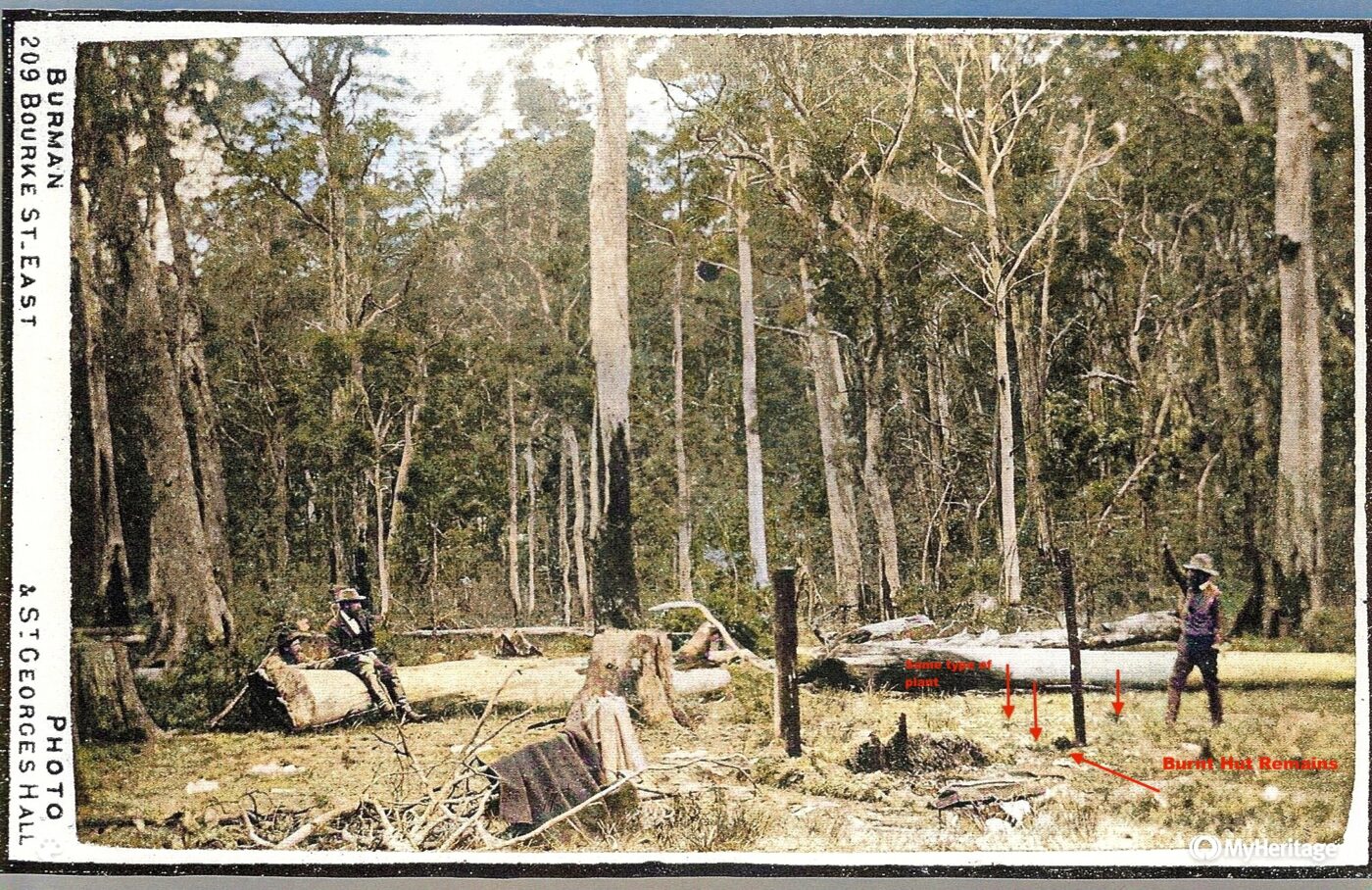
Jim ; You are raising a bit of a trick question for David. I can say without a shadow of doubt, there is a collapsed fireplace in that photo.
While Bruce highlighted the fireplaces with blue lines, there have been discussions about the two posts-whether they are the end of the hut or the side posts. On the ground at the two huts site, those post holes and more are still in place as are the rocks forming a rough C form. To be seen are also the channels that define the huts footprints. The sad thing about all this is that Heritage Victoria in 2005 said they would do an archaeology dig of the site as Gary Dean and I had permission to do a rudimentary investigation of the site as Gary was studying archaeology, but due to Ian Jones’s influence with DSE and the NK Touring route- nothing ever happened.
Attachment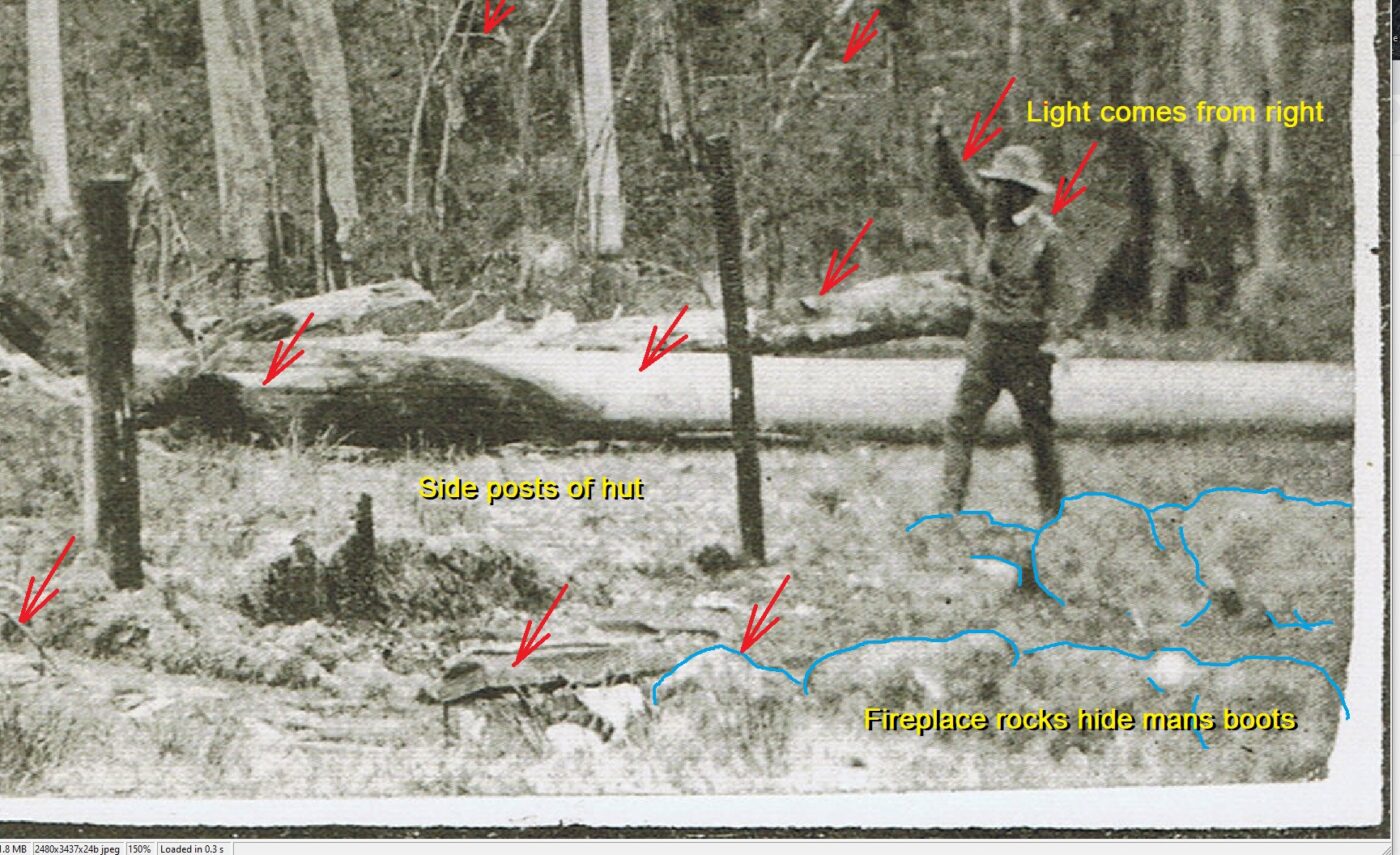
Bill, if there was a fireplace on the west side I expect there would have been a post to support the hut next to the fireplace. Similar to the other 2 posts. There are no signs of any burnt remains on that side at all.
Glenn
Attachment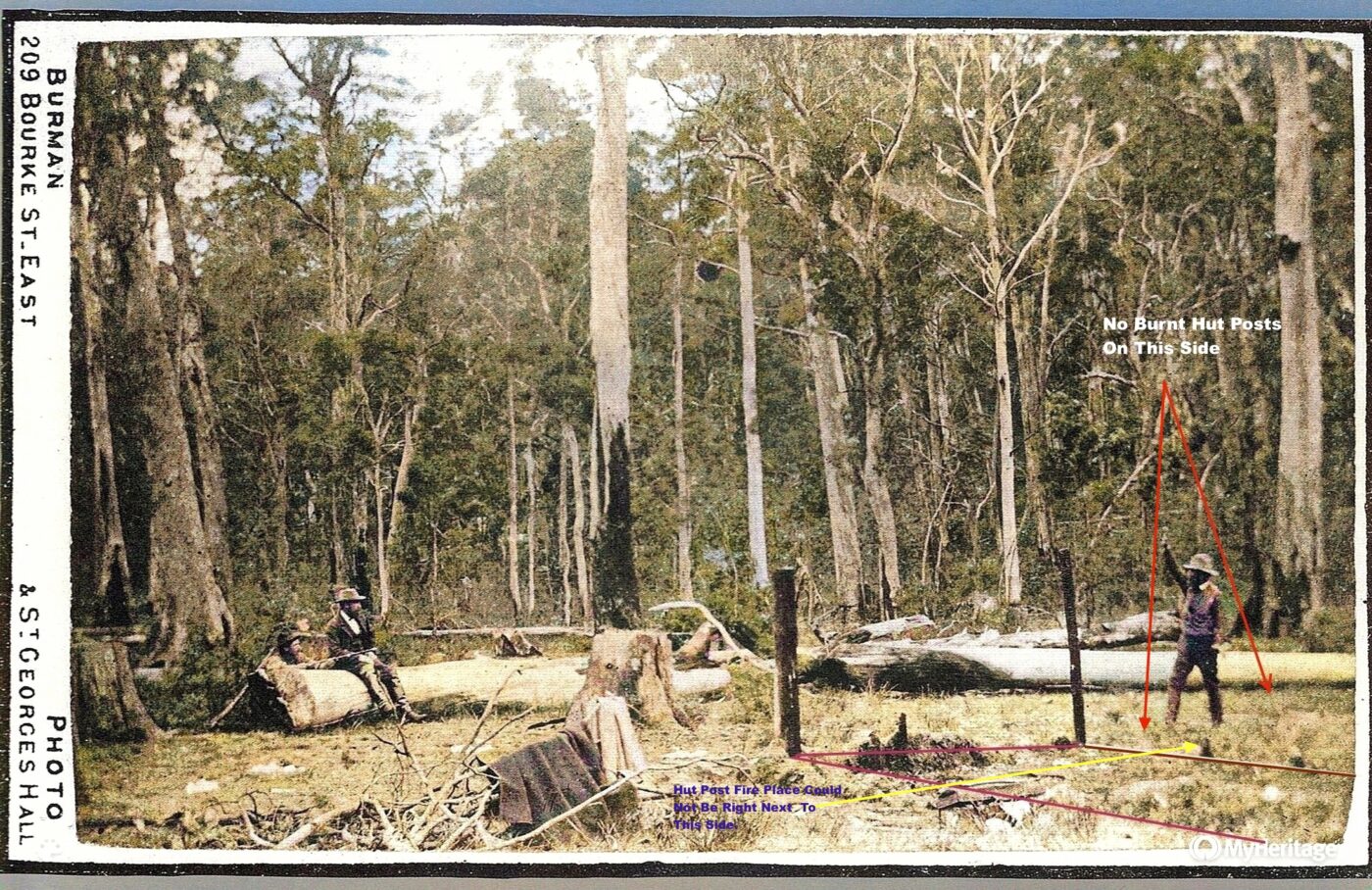
Hi Glenn, what’s your opinion of the ruined fireplaces? Can you see any collapsed fireplaces in the Burman photos? Regards, Jim
And Glenn. while youre at it can you see any evidence of the trunk of PC4 that Jim has drawn on the images to try to convince everyone that his so called Starburst tree can be seen in the. urban photos? I have looked till my eyes are red. But for the life of me I just can’t see a trunk there Jim says he can see one.
And BTW Jim can you describe what you think a collapsed fireplace should look like?
David, I’m definite about the starburst tree. The canopy shape is incredibly unusual and I haven’t been able to find anything similar along SBC. The chances of having one in the Burman photo and one living now are so remote. Its not normal canopy structure. And I identified this after our site was found.
But back to the topic now. You can only say so called (structures??) “could be” ruins of fireplaces. So does that mean the Republic “could be” a thing too?
You ask me what a collapsed fireplace should look like. My answer based on what I can see in the Burman photos, a collapsed fireplace just looks like tufts of grass. Because that’s all they are. And not even you can bring yourself to say otherwise. Or will you go on record and say without any doubt you can see 2 ruins of stone fireplaces in the Burman photos? Because if you can’t, which you haven’t been able to so far, the 2 huts theory unfortunately has collapsed. Jim
Oh come off it Jim. If you think the fireplaces are crucial to Bills Two Huts argument, then you havent been paying attention.
As for the Kennedy Tree groups claim about PC4 and the “Starburst tree’ : frankly its embarrassing. I cant believe any of you thought you would get away with claiming you had found a tree that you had to DRAW onto the photo! That thicket of branches in the Burman photo could be joined up in a hundred different ways, and its ridiculous to even imagine its possible to work out what connects to what.
Bill is making claims about something which can be SEEN in the photos – youre making claims about a tree that CANNOT EVEN BE SEEN in the photos.
And BTW Jim, has your group had any further correspondence from the authorities regarding your claim about the Kennedy Tree?
Jim its obvious to everyone youre trying to entrap me and you have something you want to spring on me if I say the wrong thing so why dont you just spit it out and make the point you are itching to make?
Not trying to trap anyone. Just want to ask you if you can see a ruined fireplace in that photo or any of the Burman photos? Fair question to ask. I know Bill says he can see 2 fireplaces. But David I’m interested to know if you do? Regards, Jim
Bill has drawn everyones attention to a dark irregular shape at the back of one of the Burman photos, and what appears to be a line of rocks in the foreground of another. We can all see these objects quite easily and Bill has suggested very plausibly, given there were once two huts at that site, that these are the ruined fireplaces from those huts. To be honest if Bill hadnt drawn my attention to them I wouldnt have known what they were, and I still dont know exactly what they might have looked like before being ruined, but they were apparently quite substantial fireplaces.
Bill will correct me if I have this wrong but I believe when he and the CSI blokes together identified this site it was not initially because of the fireplaces but because of the topography and the orientation of the slope that they were looking for. To then find what others disparage by calling them ‘piles of rocks’ would have been icing on the cake I would imagine.
Again, correct me if I am wrong but I dont believe any other site has evidence of fireplaces in such close proximity to where the tent and the logs would have been. Does your Jim?
David- So you think that rudimentary hut that was burnt down was built with a stone fireplace? And the other fireplace that is a fabric bag was a fireplace? It is a good question because you actively support the two huts location, which you are completely entitled to, but the whole thing rests on the notion that there was 2 stone fireplaces. And I can’t for the life of me find any evidence that there were 2 stone fireplaces in the Burman photos. And all the descriptions of the site of the police camp that you are happy to keep referencing don’t make any mention of them either. Can you help me understand the evidence that 2 stone fireplaces existed so close together and show in the Burman photos? I can see a bag and some tufts of grass & I have looked till my eyes are red. But for the life of me I just can’t see these 2 ruined stone fireplaces. Can you help me find them?
Well Jim, firstly ,making no mention of fireplaces doesnt rule out the possibility they were there, whereas specifically noting the absence of fences in a paddock cleared for a horse means they definitely werent.
But Jim what you CAN see for certain in the Burman images are the structures Bill has outlined in the photos, and which he believes are ruined fireplaces. It doesn’t really matter if you dont accept Bills suggestion that they are ruined fireplaces because, contrary to what you are claiming, Bills case does NOT depend on fireplaces. What Bills site depends on is the topographical finding of a slope that everyone agreed can easily be seen in the Burman photo. If nothing could be seen in the Burman photos that could be ruined fireplaces, Bills argument is unchanged and just as robust. What the fireplaces prove if nothing else is that the Two Huts site is indeed a place where people set up camp, and why wouldnt the police do so as well?
On the other hand, being able to see the trunk of the so-called ‘Starburst’ tree is critical to your case, because it forms part of your claim to have found a particular collection of old trees which is so distinctive it identifies the police camp. But you havent simply outlined an existing structure and labelled it the Starburst tree trunk – what you have done is draw a tree trunk where you wanted there to be one, even though nothing is the image suggests one is there. This fatally undermines your entire case.
And we havent even started on your claim that in the Burman Photo there is a double tree : the staggering thing to me is that you actually admit that in the Burman photo it appears to have a single trunk!…
Hi Jim, I agree with you there was never a fireplace near the mans boots. Just tufts of grass and wishful thinking.
There’s a story behind the other “fireplace” you can see this only in the Burman No.1 photo. In the Burman No.2 photo it is out of view behind the tree.
Bill takes great glee in saying that it was I who first identified it. Which is true. Early in the SBC investigation when we were still a team I was very keen to spot anything useful in the photos. I rang Bill and pointed it out to him, thinking it might be a fireplace. He very quickly liked it and ask if he could put my name to it. I hesitantly said yes. And the rest is history as they say.
I will add that I also thought and Bill should remember this, I could see a couple of long coats hanging near the base of the Burled tree and a revolver on the left side of the man with his arm raised.
So sometimes we all make mistakes, spot things within the photos that may or may not be there. Next time David rubs it in about the fence just remind him that I have a sketch from Bill who at one time could see a fence as well.
All the best, Glenn
Glenn- Thanks for your objective opinion I appreciate & respect where you come from. Out of interest, do you still see the ruined fireplace adjacent to the tree (we call PC2)? If anyone can mark it up I will be really appreciative. Happy to admit I am wrong if I can find it. I am intrigued by what you say regarding the revolver on the left side of the man with arm raised- is it that shape that looks like it is hanging on his left side near where his belt would be? And the long coats can you point out if you get the chance? It is good to have more people with more eyes pointing out as much detail as possible. Out of interest, although I agree with the SW orientation, I don’t think the shadows of the posts in the Burman photos is conclusive either. The dark patch next to right post could be burnt ground or burnt tuft of grass (could include some shadow too) but the left post doesn’t show any conclusive shadow. In front of right standing man I can only see tufts of grass on the ground. And i think if the hut that was burnt down had more than 2 posts then they would show. It was a rudimentary hut and looks to me that it was a ‘lean to’ using 2 posts. I can’t comprehend how 3 prospectors would have honestly gone to the effort of lugging stone there and constructing a stone fireplace. Enormous project to undertake. A stone fireplace would survive a fire it wouldn’t necessarily collapse. And there is nothing mentioned in any report about a stone fireplace or a collapsed stone fireplace. If anyone can point me to any reference to any mention of stone fireplaces I would genuinely love to see it. Jim
As far as light orientation- for me the details of (GW Hall) sitting on the log are interesting. You can see shadow under his hat line but his face is in light. And looking at his lower legs the front of his legs are exposed or reflecting light but you can see shadow around the underneath of his legs against the log. Regards, Jim
Attachment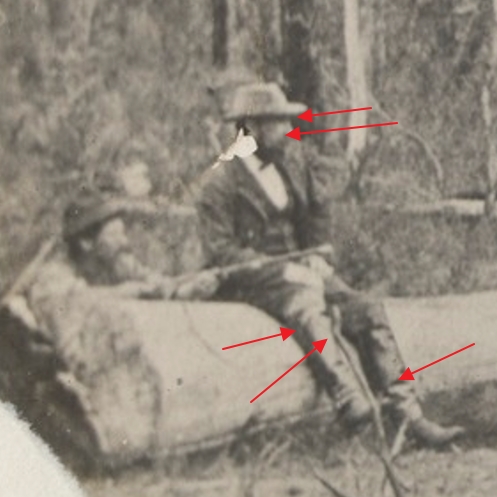
And of course, such shadows would most certainly NOT be seen if the man was facing SOUTH as Glenn and the CSI assert.
another interesting observation about the 2 burnt posts- if it was a 2 posted lean to- then the opening would be facing south so as to create shade and the blankets on the ground are therefore to the north side of the 2 posts. I don’t believe there was a stone fireplace, and i am yet to see any evidence that supports it. I think it was a rudimentary hut most likely used in the warmer months. Jim
So Glenn are you going to sit on the fence or tell Jim and me if you can see fences in the Burman photo? Or are you going to say you can see white horizontal and vertical structures which could be fences or could be something else?
David, you are saying Bill believes they are fireplaces. I’m just asking a simple and fair question. David can YOU see 2 stone fireplace remains in the Burman photos?
Yes Jim I can see structures in the images which could be ruined fireplaces, as Bill has suggested.
David.
Have a good look at Bill’s rocks image below. There are 2 dark shapes (plants/grasses whatever) of the same type each side of the post as the one next to the post. And notice next to that the black rounded “shadow” that remarkably rises up from the ground. Which also oddly also appears to be a larger diameter than the post itself.
Its still a No from me.
Glenn
Attachment
David.
Check closely both the Burman images. There is no shadow on the ground from the adjacent post or the stump on the left side. But you insist there is a shadow from that post. If that same “shadow” was on the other side of the post my answer would be the same. Glenn
Glenn I understand where you are coming from but I will restate my point one more time, and its this : you are claiming the dark structures that make a line that I say is a shadow, are not a shadow but dark tufts of grass and hut remnants. So you and I have a difference of interpretation : my point is that the Artist has provided us with the answer as to whose interpretation is correct, because he has very definitely drawn a shadow exactly where I believe I can see one.
And I will say again that your position is that only YOU have got it right : whereas three people who were much closer to the scene, two of whom actually visited the place all got it wrong : the artist got it wrong, Burman got it wrong and McIntyre got it wrong. Thats a very brave call indeed.
David. I’m sorry you disagree. Just because the artist happened to draw the shadows where you would like them doesn’t necessarily mean that he accurately drew them.
He may have thought that it was a shadow like you, keeping in mind he was likely drawing from a postcard. Or just drew some shadows to highlight the hut posts.
We are looking at a highly unlikely shadow supposedly on the left side of one hut post. Logically there should be shadow on the left side of the other post and the stump. There are none. And just as Jim pointed out in front of right standing man there are just tufts of grass on the ground.
From Bills web page: “Exhibit A’ that the magistrate dismissed because he wrote on a small piece of paper pinned to the postcard – these words, – “ Doubts as to the accuracy of the scene (leading to reconstructions), perhaps being stimulated by a sense that this is a fairly unusual piece of evidence to introduce”. (The postcard is kept at the Public Records Office of Victoria)”
“Leading to reconstructions” I guess that means the actors in the photo. McIntyre made no comment about the actors that I know of.
Glenn
Yes Glenn its possible the artist just randomly drew shadows in the place we would expect them to be if the photo was taken from the north east, and its also possible for some unknown reason McIntyre had his wires crossed when he said the picture shows the ground where Lonigan and Scanlan were killed, and its also possible Burman put his actors on the wrong side of the logs and had them facing the wrong way for some obscure and unknown random reason…
….but when you calculate the probability of three unlikely things just randomly lining up to support the view that the images were taken from the north east, when they were NOT taken from the north east, then you end up with an event that has a really very LOW probability..not impossible I grant you, but it would be rational to regard the most likely possibility as the best explanation for something, not the least likely one as you and the CSI do.
David, where do you think Scanlan was when he was shot?
Glenn
Youre really clutching at semantic straws now Glenn. Its getting tedious. But Lonigan was clearly killed in front of the logs in the space shown in the photos, and Scanlan was killed a little further back, maybe out of view but it was in that area…but your view is that the area shown was NOT in any way capable of being labelled the ‘ground’ where ANYONE was killed.
Glenn – I think you meant to say “likely drawing from a photograph” not “likely drawing from a postcard” as written”?
Thanks Anonymous. Glenn
David. You believe McIntyre used the Burman photo to create his detailed (map) diagram. Suffering from severe trauma he was unable to fully remember the place, lost his sense of direction and drew the wrong logs. Thankfully Bill corrected it, included the log that McIntyre should have drawn and rotated them all a little so they now face the right direction. South. By doing so you clearly know where Lonigan was when shot.
McIntyre recovered by the time of the trial and using the photo identifies the ground where Lonigan and Scanlon were shot.
McIntyre also described by diagram the positions of the men etc. during the trial ……. Sooner or later he must have twigged that something was wrong.
Glenn
Attached is the Burman No1 photo indicating the locations of Lonigan and Scanlon according to McIntyre’s unaltered detailed diagram.
Attachment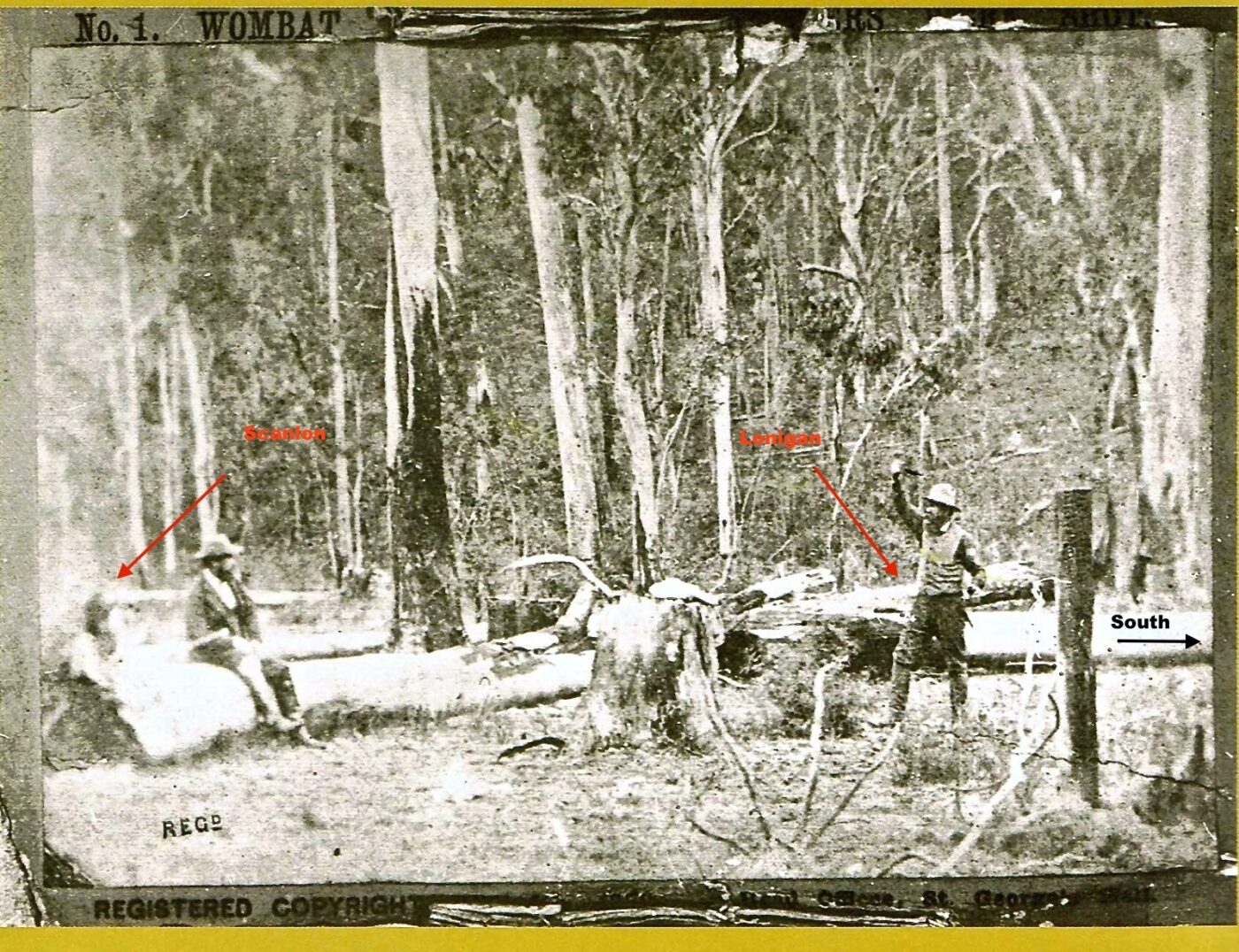
So, according to Glenn, McIntyre was wrong to say that the image shows the ground where Lonigan and Scanlan fell. ( I assume this because the arrows he has drawn in the image above point to places not seen in the image, unseen ground on the other side of the Logs. )What McIntyre was looking at in this image , according to the CSI mob and the Toad Mick Fitzsimons, is the ground immediately in front of the tent; the ground where the troopers were killed was on the other side of the logs.
I think most rational people can see what a mess the CSI and the Toads position is : it requires them to mock the intelligence and the sanity of McINtyre, of Burman and of the Artist who redrew those images into etchings for publication : ALL these people got it wrong but the Toad and the CSI mob : well THEY know better than people who were on the ground when all this happened 140 years ago…yeah right! and two burls that dont look the same are identical!
There is very little about their argument thats rational, or logical or in good faith. Same can be said for the Kennedy tree arguments for their trees : claiming to have found a tree they drew onto a 140 year old photo is an absolute joke…surely Glenn you would agree with that?